Medieval Torture |
| MEDIEVAL WARFARE |
MEDIEVAL WEAPONS |
CRUSADES & CRUSADERS |
WILLIAM MARSHAL |
MEDIEVAL LIFE |
MEDIEVAL TORTURE |
|
In the middle ages torture was used to extract information, force confessions, punish suspects, frighten opponents, and satisfy personal hatred. The word 'torture' comes from the French torture, originating in the Late Latin tortura and ultimately deriving the past participle of torquere meaning 'to twist'. Many tortures rely on a twisting of the limbs, twisting ligatures, or turning screw mechanisms. For the most part capital punishments in Christendom have been deliberately painful. Severe historical penalties include the breaking on the wheel, boiling to death, burning, crucifixion, crushing, disembowelment, dismemberment, flaying, impalement, sawing, scaphism and stoning. Historically, ancient Greeks and Romans used torture for interrogation. Until the second century AD, torture was used only on slaves.. A slave's testimony was admissible only if extracted by torture, on the assumption that slaves could not be trusted to reveal the truth voluntarily. Medieval and early modern European courts used torture, depending on the accused's alleged crime and social status. Torture was deemed a legitimate means to extract confessions or to obtain the names of accomplices or other information about a crime. In theory, it was permitted only if there was already half-proof against the accused. Defendants already sentenced to death would be tortured to force them to disclose the names of accomplices.
Torture was used almost exclusively for the crime of treason. In civil society this meant in practice that it was generally restricted to monarchs and the highest nobles. In the Church, matters were different. The Church taught that any deviation from orthodoxy amounted to lčse majesté against God, and therefore treason again the King of Kings. This meant that in contrast to civil society, treason and therefore torture were common in the Church. It was not only the Inquisition that practised torture but it is the Inquisition that has lodged in the popular mind as masters of the trade. As many historians have noted, the most vicious procedures in Medieval times were inflicted on devout Christians by even more devout Christians. Dominicans gained a reputation as the most fearsomely innovative torturers. Torture had long been practised by bishops, but it was formally authorised for the Medieval Inquisition in 1252. It should have ended in 1816 when a papal bull forbade its use, but secret torture continued in the Papal States until they were seized by French Forces in the 1870s. Torture was usually conducted in secret, often in secure underground dungeons. In contrast, torturous executions were usually public, and drew large crowds of spectators. Public holidays were often declared and free penances given to spectators to ensure large attendences. Deliberately painful methods of execution for severe crimes were taken for granted as part of justice until the development of Humanism in 17th century philosophy, and "cruel and unusual punishment" was denounced in the English Bill of Rights of 1689. The Age of Enlightenment in the western world further developed the idea of universal human rights. The adoption of the Universal Declaration of Human Rights in 1948 marks the recognition of a general ban of torture by all UN member states.
|
|
|||||||||||||||||||||||||||||||||||
|
|
||||||||||||||||||||||||||||||||||||
Torture and Execution Methods
Remarkable ingenuity has been shown in the invention of instruments and techniques of physical torture.
Here is our classification of torture types with examples of corresponding torture devices
|
|
|||||||||||||||||||||||||||||||||||
Torture and Execution Devices |
|
|||||||||||||||||||||||||||||||||||
Axes and Swords for Beheading
Beheading was a form of execution rather than a form of torture, but it could form part of a programme of torture. For example beheading was a part of the process of drawing, hanging, and quartering. Decapitation has been used as a form of capital punishment for millennia. The terms "capital offence", "capital crime", "capital punishment," derive from the word caput, Latin for "head", referring to the punishment for serious offences involving the forfeiture of the head. Decapitation by sword or axe was considered the "honourable" way to die for a noble, who, being a warrior, could often expect to die by the sword in any event. In England it was considered a privilege of noblemen and noblewomen to be beheaded. Others suffered a dishonourable death death on the gallows or through burning at the stake. In medieval England the penalty for treason by men was to be hanged, drawn, and quartered. The penalty for women traitors was to be burned at the stake. In practice sentences of nobles were almost always commuted to beheading. In legends of Christian martyrdom the fictitious saints withstood all attempts to execute them, until the wicked heathens finally beheaded them.
To ensure that the blow would be fatal, executioners' swords were usually blade-heavy two-handed swords. If an axe was used, it almost invariably would be wielded with both hands. In England a special form of axe was used for beheadings, with the blade's edge extending downwards from the tip of the shaft. Anne Boleyn and Catherine Howard, first cousins and the second and fifth wives of King Henry VIII were both condemned to be burnt alive for adultery, but on Henry's orders they were both beheaded. Lady Jane Grey was also condemned to burn as a traitoress but again the sentence was commuted to beheading by Mary I. |
|
|||||||||||||||||||||||||||||||||||
Barrel Pillory, or Spanish Mantle
For a short time this was merely unpleasant, but prolonged confinement could cause death through hunger or thirst, or scaphism - allowing or encouraging insects to breed on and feed on the victim's flesh. The defenceless individual's faeces accumulated within the container, attracting ever more insects, which would eat and breed within his or her exposed and often gangrenous flesh. Feeding the victim would often be allowed each day in some cases to prolong the torture, so that dehydration or starvation did not provide him or her with the release of death. Delirium would typically set in after a few days. Death, when it eventually occurred, was probably due to a combination of dehydration, starvation and septic shock.
Drunkard’s CloakA less horrific variation was used to punish drunkards, the feet projecting through the bottom of the barrel. It was used for a range of other misdemeanours, often represented pictorially on the exterior of the barrel. In 1655, Ralph Gardner wrote that in Newcastle-upon-Tyne, England “he hath seen men drove up and down the streets with a great tub or barrel opened in the sides, with a hole in one end to put through their heads, and so cover their shoulders and bodies, down to the small of their legs, and then close the same, called the newfangled cloak, and so make them march to the view of all beholders; and this is their punishments for drunkards and the like.” In 1641, the diarist John Evelyn wrote that in Delft, Holland the Senate House contained “a weighty vessel of wood, not unlike a butter churn, which the adventurous woman that hath two husbands at one time is to wear on her shoulders, her head peeping out at the top only, and so led about the town, as a penance for her incontinence” The Drunkard’s Cloak was used in 1862 on soldiers in the American Civil War. An eyewitness “was extremely amused to see a rare specimen of Yankee invention, in the shape of an original method of punishment drill. One wretched delinquent was gratuitously framed in oak, his head being thrust through a hole cut in one end of a barrel, the other end of which had been removed; and the poor fellow loafed about in the most disconsolate manner, looking for all the world like a half-hatched chicken”. |
|
|||||||||||||||||||||||||||||||||||
Boiling Water
This was more frequently a way to execute a prisoner rather than to extract a confession. In England, statute 22 passed in 1531 by Henry VIII, made boiling a legal form of capital punishment. It began to be used for murderers who used poisons after the Bishop of Rochester's cook gave a number of people poisoned porridge, resulting in two deaths in February 1531. It was employed again in 1542 for a woman who used poison. The act was repealed in 1547. This form of capital punishment was also used for counterfeiters and coin forgers during the Middle Ages (who were technically guilty of treason) |
|
|||||||||||||||||||||||||||||||||||
|
Boot, Spanish Boot, Buskin & Foot Press
Spanish Boot
Forerunners of the archetype can be found dating back as far as a thousand years. The first Scottish effort, referred to as a buskin, made use of a vaguely boot-shaped rawhide garment that was soaked with water, drawn over the foot and lower leg, and bound in place with cords. This contraption was heated over a gentle fire, drastically contracting the rawhide and squeezing the foot until the bones were dislocated, though there would not have been sufficient pressure actually to crush the bones of the foot. A variant, found in both the British Isles and France, consisted of a trio of upright wooden boards that splinted around and between the feet and were tied in place by cords. Wedges were hammered between the boards and the feet to dislocate and crush the bones. An example from Autun, France, consisted of high boots of spongy, porous leather that were drawn over the feet and legs. Boiling water was poured over the boots, eventually soaking through the leather and eating the flesh away from the feet.
The BootOversized boots of iron or copper, often brazed onto the floor, received the prisoner's bare feet as he lay in stocks or sat bound in a chair. The boots were filled with boiling water, or molten lead, to consume the feet and legs. A variant applied in Ireland to Dermot O'Hurley consisted of lightweight metal boots that were filled with cool water and heated with the feet inside over a fire until the water boiled.
Foot press or Foot screwThe foot press or foot screw consisted of a pair of horizontal iron plates tightened around the foot by means of a crank mechanism to lacerate the flesh and crush the bones of the foot. Although it was standard to line the lower plate with ribs to prevent the bare foot from popping out of the grip of the instrument as it became sweatier, a crueller variant of this device in Nuremberg lined the upper plate with hundreds of sharp spikes. A version from Venice connected the crank mechanism to a drill, so that a hole was drilled in the centre of the instep while the instrument was tightened. |
|
|||||||||||||||||||||||||||||||||||
Instep Borer
A crank projected from a housing over the instep, which concealed a long, thick, serrated iron blade, grooved so as to inflict maximum damage and promote liberal blood flow. Turning the crank slowly advanced the blade into the boot, punching a hole through the centre of the instep. The resultant wound was so large that it was common for the prisoner to die of toxaemia soon after. It seems that the instep borer was used only in Nuremberg. |
|
|||||||||||||||||||||||||||||||||||
Branding Irons
Human branding or stigmatising is the process in which a mark, usually a symbol or ornamental pattern, is burned into the skin of a living person, with the intention that the resulting scar makes it permanent. This is achieved using a very hot or very cold branding iron. In criminal law, branding with a hot iron was a mode of punishment by which marking the subject as if goods or animals, sometimes concurrently with a reduction of status. Brand marks have also been used as a punishment for convicted criminals, combining physical punishment, as burns are very painful, with public humiliation, especially if marked on a normally visible part of the body, providing an indelible criminal record The punishment was adopted by the Anglo-Saxons, and the ancient law of England authorised the penalty. By the Statute of Vagabonds (1547) under King Edward VI, vagabonds and Gypsies were ordered to be branded with a large V on the breast, and brawlers with F for "fraymaker"; slaves who ran away were branded with S on the cheek or forehead. This law was repealed in England in 1550. From the time of Henry VII, branding was inflicted for all offences which received Benefit of clergy (branding of the thumbs was used around 1600 at Old Bailey to ensure that the accused who had successfully used the Benefit of Clergy defence, by reading a passage from the Bible, could not use it more than once), but it was abolished for such in 1822. In 1698 it was enacted that those convicted of petty theft or larceny, who were entitled to benefit of clergy, should be "burnt in the most visible part of the left cheek, nearest the nose." This special ordinance was repealed in 1707. James Nayler, a Quaker who in the year 1655 was accused of claiming to be the Messiah, convicted of blasphemy in a highly publicised trial before the Second Protectorate Parliament and had his tongue bored through and his forehead branded B for 'blasphemer'. In the 16th century, German Anabaptists were branded with a cross on their foreheads for refusing to recant their faith and join the Roman Catholic Church. In the North-American Puritan settlements of the 17th century, men and women sentenced for having committed acts of adultery were branded with an "A" letter on their chest (men) or bosom (women). Canon law sanctioned the punishment, and in France, in royal times, various offences carried the additional infamy of being branded with a fleur de lys. In Germany however, branding was illegal. In the Lancaster criminal court a branding iron is still preserved in the dock. It is a long bolt with a wooden handle at one end and an M (malefactor) at the other; close by are two iron loops for firmly securing the hands during the operation. The brander would, after examination, turn to the judge and exclaim"A fair mark, milord." Criminals were formerly ordered to hold up their hands before sentence to show if they had been previously convicted. In the 18th century, cold branding or branding with cold irons became the mode of inflicting the punishment on prisoners of higher rank. "When Charles Moritz, a young German, visited England in 1782 he was surprised at this custom, and in his diary mentioned the case of a clergyman who had fought a duel and killed his man in Hyde Park. Found guilty of manslaughter he was burnt in the hand, if that could be called burning which was done with a cold iron" (Markham's Ancient Punishments of Northants, 1886). Such cases led to branding becoming obsolete, and it was abolished in 1829 except in the case of deserters from the army, which were marked with the letter D, not with hot irons but by tattooing with ink or gunpowder. |
|
|||||||||||||||||||||||||||||||||||
Branks or Scold's bridle or Gossip's Bridle
A scold's bridle, sometimes called a "branks", was a punishment device usually for for women, also used as a 'mild' form of torture. It was an iron muzzle or cage for the head with an iron curb-plate projecting into the mouth and pressing down on top of the tongue. The 'curb-plate' was often studded with spikes so that if the tongue remained lying calmly in place, it inflicted a minimum of pain. The branks was used as a formal legal punishment, first recorded in Scotland in 1567. Branks were also used in England, where it may not have been formally legalised as a punishment. Kirk-sessions and barony courts in Scotland inflicted it upon transgressors or women that were considered to be 'naggers' or 'common scold' . Branking was a punishment for"'gossips", "shrews" or "scolds" (women of the lower classes whose speech was "riotous" or "troublesome") and women accused of witchcraft by preventing them from speaking. It was also used as corporal punishment for other offences, notably on female workhouse inmates. The women were placed in a public place for additional humiliation and were sometimes beaten. Once the branks was placed on the 'gossip's' head, they would be led through town to show that they had been doing something wrong or scolding too often. This would also humiliate them into 'repenting' their 'riotous' actions. Quaker women were punished with the branks for preaching in public places. In 1567 Bessie Tailiefeir slandered Baillie Thomas Hunter in Edinburgh, saying that he was using false measures. She was sentenced to the brankit and set on the cross for one hour. In Walton on Thames, in England, a scold's bridle is displayed in the vestry of the church. It is dated 1633, with the inscription "Chester presents Walton with a bridle, To curb women's tongues that talk too idle." The story is that a man called Chester lost a fortune due to a Walton woman's gossip, and presented the town with the instrument of torture out of anger and spite. The branks was in use at Bolton-le-Moors, Lancashire as late as 1856.
|
|
|||||||||||||||||||||||||||||||||||
VariantsVariants might be shaped like an animal's head, for example a cow for a lazy bones, a donkey for a fool, a hare for an eavesdropper or a pig for a glutton. Alternatively, another part of the body could be restrained as in a Shrew's Fiddle or a Noisemaker's Fife
This is a double Shrews' Fiddle at the torture museum in Freiburg im Breisgau. It was used when two women had an unseemly public argument. They were locked together facing each other, both equally helpless and humiliated. They were obliged to remain locked together until reconciled to each other. The photograph on the right shows a modern reconstruction. |
|
|||||||||||||||||||||||||||||||||||
Brazen Bull
The Brazen Bull was invented in Ancient Greece by Perillos of Athens. Perillos proposed his idea of a painful means of execution to Phalaris, the tyrant of Akraga. Phalaris liked the idea of the Brazen Bull, and had one made made. Once finished, Phalaris ordered it to be tested on Perillos himself. The Bull was made wholly of brass. It was hollow and furnished with a door in the side. When a victim was placed inside the brazen bull, he or she was roasted to death by a fire lit underneath it. A system of tubes made the victim's screams sound like an infuriated bull, and also made the bull's muzzle snort smoke. In the Middle Ages it was used in Central Europe. |
|
|||||||||||||||||||||||||||||||||||
Breaking Wheel
see Wheel |
||||||||||||||||||||||||||||||||||||
Burning
As a form of torture the victims feet could be held to a fire, or trapped into metal boots that were heated up, or they could be strapped into an iron chair with a fire lit underneath, or red hot irons could be applied. Metal torture instruments were often heated - pincers, pliers and so on. Burning or molten liquids could also by used, the victims being forced to dip limbs in them or even having them poured down their throats. According to the Talmud, the "burning" mentioned in the Bible was done by melting lead and pouring it down the convicted person's throat, causing immediate death. The particular form of execution by burning in which the condemned is bound to a large stake is more commonly called burning at the stake. As a form of capital punishment, burning has a long history for crimes such as treason (heresy, blasphemy and witchcraft being regarded by the Christian Churches as treason against God). Sodomy was also punished by burning alive, again because it was seen as a crime against God.
Adopting an old Roman practice, the Christian Church adopted burning as a favoured form of capital punishment. Under the Byzantine Empire, burning was introduced as a punishment for Zoroastrians because of the erroneous belief that they worshiped fire. The Christian Emperor Justinian (r. 527-565) ordered death by fire, and confiscation of all possessions by the State as the punishment for heresy against the Christian faith in his Codex Iustiniani (CJ 1.5.), ratifying the decrees of his predecessors the Christian Emperors Arcadius and Flavius Augustus Honorius. In 1184, the Roman Catholic Synod of Verona confirmed this form of punishment, legislating that burning was to be the official punishment for heresy, as Church policy was against the spilling of blood. It was also widely believed that the condemned would have no body to be resurrected in the afterlife. This decree was reaffirmed by the Fourth Council of the Lateran in 1215, the Synod of Toulouse in 1229, and numerous spiritual leaders up to the nineteenth century.
Civil authorities burnt persons judged to be heretics under the medieval Inquisition, Burning was also used by Protestants during the witch-hunts of Europe. Among the best-known individuals to be executed by burning were Jacques de Molay (1314), Jan Hus (1415), St. Joan of Arc (30 May 1431), Savonarola (1498) Patrick Hamilton (1528), John Frith (1533), William Tyndale (1536), Michael Servetus (1553), Giordano Bruno (1600) and Avvakum (1682). Anglican martyrs Hugh Latimer and Nicholas Ridley (both in 1555) and Thomas Cranmer (1556) were also burnt at the stake. If the fire was large (for instance, when a large number of prisoners were executed at the same time), death often came from smoke inhalation or carbon monoxide poisoning before flames actually caused harm to the body. If the fire was small, however, the convict would burn for some time until death from heatstroke, shock, loss of blood or the thermal decomposition of vital body parts. Several records report that victims took over 2 hours to die. In many burnings a rope was attached to the convict's neck passing through a ring on the stake and they were simultaneously strangled and burnt.
When this method of execution was applied with skill, the condemned's body would burn progressively in sequence: calves, thighs and hands, torso and forearms, breasts, upper chest, face before death intervened. When the Catholic Inquisitions burned people they generally ensured a good distance between the flames and the victim, so that he or she was actually roasted to death rather than burned to death. In later years in England some burnings only took place after the convict had already hanged for half an hour. In many areas in England condemned woman (men were hanged, drawn, and quartered) was seated astride a small seat called the saddle which was fixed half way up a permanently positioned iron stake. A similar "seat" resembling a peg can be seen between the legs of the male victims in the painting of St Dominic presiding over an Auto-da-fe, shown on the right. In Britain the stake was about 4 metres high and had chains hanging from it to hold the condemned woman still during her punishment. Having been taken to the place of execution in a cart with her hands firmly tied in front of her she was lifted over the executioner's shoulder and carried up a ladder against the stake to be sat astride the saddle. The chains were then fastened and sometimes she was painted with pitch which was supposed to help the fire to burn her quicker. Edward Wightman, a Baptist from Burton on Trent, was the last person to be burnt at the stake for heresy in England in the market square of Lichfield, Staffordshire on 11 April 1612.
|
|
|||||||||||||||||||||||||||||||||||
Cat o' Nine Tails
The cat o' nine tails, commonly shortened to the cat, is a type of multi-tailed whipping device that originated as an implement for severe physical punishment, notably in the Royal Navy and Army of the United Kingdom, and also as a judicial punishment in Britain and some other countries. The cat is made up of nine knotted thongs of cotton cord, about 2 1/2 feet or 76 cm long, designed to lacerate the skin and cause intense pain. It traditionally has nine thongs as a result of the manner in which rope is plaited. Thinner rope is made from three strands of yarn plaited together, and thicker rope from three strands of thinner rope plaited together. To make a cat o' nine tails, a rope is unraveled into three small ropes, each of which is unraveled again. |
 |
|||||||||||||||||||||||||||||||||||
Chair of Torture or Iron Chair
There are many variants of the chair, though they all have spikes covering the back, arm-rests, seat, leg-rests, and foot-rests. The number of spikes ranges from 500 to 1,500.
In some versions of iron chair, there were holes under the chair's bottom where the torturer placed red hot coal to cause severe burns. In other versions weights would be placed on the victim's thighs or feet. In some there were spikes on the head rest. It was a common practice to extract a confession by forcing one victim to watch another being tortured with this instrument. No spikes penetrated a vital organ and wounds were closed by the spikes themselves, this delayed blood loss and ensured a lingering death. |
|
|||||||||||||||||||||||||||||||||||
Crushing Devices
Sometimes the crushing was achieved by hammering wedges into constrained spaces where the limbs were confined - see Boot. Tools resembling nut crackers could also inflict significant pain when applied to various parts of the body. |
|
|||||||||||||||||||||||||||||||||||
Cucking Stool
see Ducking Stool |
||||||||||||||||||||||||||||||||||||
Denailing Devices
Denailing-the forcible extraction of the fingernails or toenails, or both, was a favourite method of medieval torture, the quicks under the nails being particularly sensitive.. In its simplest form, the torture is conducted by constraining the prisoner on a tabletop and using a metal forceps or pliers (often heated red-hot) to grasp each nail in turn and tear it from the finger or toe. A crueller variant used in medieval Spain introduced a sharp wedge of wood or metal between the flesh and each nail. The wedge was slowly hammered ever further under the nail until it was torn free. Medieval German witch-hunters conducted this torture with rough wooden skewers dipped in boiling sulphur. A number of skewers were slowly driven into the flesh under the prisoner's toenails. Alternately, the skewer could be dipped in boiling oil, which served a dual purpose of burning the incredibly sensitive flesh and lubricating the skewer so that the torturer could more easily explore the surface area beneath the nail. When enough skewers had been driven home to pry each nail loose from its bed, the nail was torn out at the root with a pair of pliers. |
|
|||||||||||||||||||||||||||||||||||
Drugs
Although poorly documented, it is clear that some torturers were familiar with a range of drugs that could elicit confessions even when physical torture failed. Medieval monasteries were expert in all kinds of herb, including toxins and hallucinogens. The following is from H. Sidky's Witchcraft, Lycanthropy, Drugs and Disease (pp. 208-211)
|
|
|||||||||||||||||||||||||||||||||||
Drunkards' Cloak
see Barrel Pillory |
||||||||||||||||||||||||||||||||||||
Ducking Stool, Cucking Stool
|
|
|||||||||||||||||||||||||||||||||||
Exposure
Victims could be exposed to the elements by restraining them. In winter exposure could cause death, even for example in the stocks or pillory, or tied to a whipping post In winter a torturer could poured water over a victim's head which eventually became frozen causing the victim to die slowly and painfully. Sometimes the body was left for the winter to dissuade any further crimes. Alternatively, The victim could be buried up to his neck letting any animals, insects or other people kill him slowly. In addition to regular restraint, the gibbet, a large basket made of iron or other metal, with holes large enough for arms and legs, but not for an entire body to fit through, would be hung from a pole with a person inside it. During hot days, the metal would heat, causing pain. During cold days and nights, the chill, as well as lack of protection from the wind, could easily sap a victim's body heat. Holes in the grating were also big enough to allow carrion birds to enter and pluck at a victim's skin and eyes. Due to its cost efficiency and cruelty, the exposure torture was very widespread in medieval Europe. The victim's remains often served as a warning to the population. In many cases, the victim was sentenced to a short period of exposure, depending on the crime. However, death was frequent since they were completely defenceless |
|
|||||||||||||||||||||||||||||||||||
Flaying Knives (skinning knives)
Flaying alive, ie removing the skin, has been widely but infrequently employed in |Christendom. In 415, the philosopher Hypatia of Alexandria was flayed alive by a Christian mob led by St Cyril. Pierre Basile for shot and killed King Richard I of England with a crossbow at the siege of Chalus in March 1199. Although the king forgave him before he died, Basile was flayed subsequently alive after the King's death, by order of the mercenary leader Mercadier. in 1303 the Subprior and the Sacrist of Westminster Abbey broke into the Chapel of the Pyx and treasury chamber, and stole from the contents. It is thought that he was flayed, as the Pyx chapel door has been found to have fragments of human skin attached to it (as have the three doors to the revestry). According to well documented ancient traditions, a number of churches in Essex, once had human skins nailed to the Church door (as a warning to pagan Danes). Searing or cutting the flesh from the body was sometimes used as part of the public execution of traitors in medieval Europe. A similar mode of execution was used as late as the early 18th century in France; one such episode is recounted in the opening chapter of Michel Foucault's Discipline and Punish (1979). |
|
|||||||||||||||||||||||||||||||||||
Flogging Eqipment: Whips, Flails, Cats o'Nine Tails
Flagellation or flogging is the act of methodically beating or whipping the human body. The word comes from the Latin flagellum, "whip". Specialised implements for flogging include whips, rods, switches, the cat o' nine tails. Typically, flogging is imposed on an unwilling subject as a punishment; but was also undergone voluntarily by religious and sadomasochistic individuals. As in many forms of torture practised within Christendom, flogging provided a pretext to expose women's naked or semi naked bodies. Inquisitors and witch finders were renowned for finding reasons for exposing female bodies. A Christian flagellant sect was immensely popular in the Middle Ages. In some circumstances the word "flogging" is used to include any sort of corporal punishment, including birching and caning. However, in British legal terminology, a distinction was drawn (and still is, in some ex-colonial territories) between "flogging" (with a cat-o'-nine-tails) and "whipping" (formerly with a whip, but since the early 19th century with a birch). In Britain these were both abolished in 1948. A common form of punishment was to be flogged at a whipping post and then taken to the pillory. This might account for the expression "from pillar to post". The post was a whipping post and the pillar was the pillory. The original version of our idiom, which first appeared around 1420, was the other way around: from post to pillar.
With the prisoner stripped and bound, either one or two floggers administered the prescribed number of strokes, or "lashes," to the victim's back. If the offender had fainted from blood loss or suffered extreme skin and flesh loss from the back, the punishment was usually suspended until the offender had been restored to consciousness (i.e. a bucket of water splashed on his face). Once the prisoner was conscious, the remainder of the required lashes were administered. Punishment was usually limited to 20, 50 or 100 lashes at one flogging, though records exist of prisoners in the nineteenth century receiving more than 3,000 lashes over a number of months or years. Following the whipping, the prisoner's lacerated back was normally rinsed with brine. While this caused additional pain, the brine was intended to serve as an antiseptic. |
|
|||||||||||||||||||||||||||||||||||
Garrote
A garrote or garrotte is a handheld weapon, most often referring to a ligature of chain, rope, scarf, wire or fishing line used to strangle someone. The term especially refers to an execution device but is sometimes used in assassination. A garrote can be made out of many different materials, including ropes, tie wraps, fishing lines, nylon, and even guitar strings, telephone cord and piano wire. Sometimes a stick used to tighten the garrote like a tourniquet. The Spanish name refers to such a rod. In Spanish. In fact the word garrote is used variously to denote the rod, the ligature, or a device used to constrain the victim and mechanise the garrotting process. One of the first depictions of a garrote occurs in Pedro Berruguete's painting of, Saint Dominic presiding over an Auto-da-fe, reproduced elsewhere on this page (see Burning) At one point execution victims were killed by beating with a club while constrained. Garrotting equipment was later refined to consist of a seat to restrain the condemned person, while the executioner tightened a metal band around his or her neck with a crank or a wheel until suffocation of the victim was accomplished.
In the 1810s, the earliest known metallic versions of garrotes appeared and started to be used in Spain. On 28 April 1828, the garrotte was declared the sole civilian execution method in Spain. Some versions of this device incorporated a fixed metal blade or spike directed at the spinal cord to hasten the breaking of the neck. The spiked version, called the Catalan garrote, was used until 1940. American authorities kept the garrote as a form of execution in the Philippines after that Spanish colony was captured in 1898. In May 1897, the last public garroting was carried out in Spain, in Barcelona. After that, all executions would be held in private inside prisons (even if the press took photos of some of them). In March 1974 Heinz Ches (real name Georg Michael Welzel) and Salvador Puig Antich, both concvicted of killing police officers, were executed by garrotting. These were to be the last state-sanctioned garrotings in the world. In Spain,garroting was abolished, along with the death penalty, in 1978. in 1990, Andorra, in 1990 became the last country to abolish the death penalty by garroting, |
|
|||||||||||||||||||||||||||||||||||
Gibbet
A human shaped cage was known as a gibbet. It could be used as a form of torture, exposing victims to the elements, animals, and hunger and thirst. It could also be used as a method of close confinement and public humiliation. Finally it could be used as a post mortem punishment, supplementary to execution, generally as a deterrent to others. In England gibbeting was common law punishment, which a judge could impose in addition to execution. Exhibiting a body in a gibbet could 'backfire' against a monarch, especially if he was unpopular and the victim popular. Henry of Montfort and Henry of Wylynton, enemies of Edward II, were drawn and hanged before being exhibited on a gibbet near Bristol. People made relics of these bloody and mutilated remains and surrounded them with respect in violent protest. Bogus miracles were organised at the spot where the bodies were hanging. In cases of hanging, drawing and quartering, the body of the criminal was cut into four or five portions, with each gibbeted in a different place. In some cases, the bodies would be left until their clothes rotted or even until the bodies were almost completely decomposed, after which the bones would be scattered. Oliver Cromwell was gibbeted after his death when monarchists disinterred his body during the restoration of the monarchy. Pirates were sometimes executed by hanging on a gibbet erected close to the low-water mark by the sea or a tidal section of a river. Their bodies would be left dangling until they had been submerged by the tide three times. In London, 'Execution Dock' is located on the north bank of the River Thames in Wapping; after tidal immersion, particularly notorious criminals' bodies could be hung in cages a little further downstream at either Cuckold's Point or Blackwall Point, as a warning to other waterborne criminals of the possible consequences of their actions. There was objection that these displays offended foreign visitors and did not uphold the reputation of the law, though the scenes even became gruesome tourist attractions. So that the public display might be prolonged, bodies were sometimes coated in tar or bound in chains. Sometimes, body-shaped iron cages were used to contain the decomposing corpses. For example, in March 1743 in the town of Rye, East Sussex, Allen Grebell was murdered by John Breads. Breads was imprisoned in the Ypres Tower and then hanged, after which his body was left to rot for more than 20 years in an iron cage on Gibbet Marsh. The cage and Breads' skull are still kept in the Town Hall. The Common Law on Gibbeting was supplemented in England by the Murder Act 1752, which explicitly empowered judges to impose gibbeting for murder. It was most often used for traitors, murderers, highwaymen, pirates, and sheep-stealers, and was intended to discourage others from committing similar offences. The structures were therefore often placed next to public highways (often at crossroads) and waterways. There are many places named Gibbet Hill in England. The Murder Act 1751 stipulated that "in no case whatsoever shall the body of any murderer be suffered to be buried". The cadaver was either to be publicly dissected or left "hanging in chains" ie a gibbet. Since early times Christians had been keen not to allow their enemies bodies to be buried as this was popularly thought to be necessary for resurrection (this was also why heretics were burned and their ashes scattered, and why amputees were buried with their severed limbs wherever possible) Samuel Pepys expressed disgust at the practice. The sight and smell of decaying corpses were offensive, and regarded as "pestilential", so a threat to public health. The last two men gibbeted in England were William Jobling and James Cook, both in 1832. Their cases are good examples of the different attitudes to the practice. William Jobling was a miner hanged and gibbeted for the murder of Nicholas Fairles, a colliery owner and local magistrate, near Jarrow, Durham. After being hanged the body was taken off the rope, and loaded into a cart and taken on a tour of the area before arriving at Jarrow Slake where the crime had been committed. Here the body was placed into an iron gibbet cage. The cage and the scene were described thus:
The gibbet was a foot in diameter with strong bars of iron up each side. The post was fixed into a one-and-a-half ton stone base, sunk into the Slake. The body was soon removed by fellow miners and given a decent burial. James Cook was a bookbinder convicted of the murder of his creditor Paas, a manufacturer of brass instruments, in Leicester. He was executed on Friday 10 August 1832 in front of Leicester prison. Afterwards:
His body was to be displayed on a purpose-built gallows 33ft high in Saffron Lane near the Aylestone Tollgate. According to The Newgate Calendar:
In 1834 gibbeting was abolished in England, but In 1837 the body of John McKay was gibbeted on a tree near the spot where he murdered Joseph Wilson near Perth, Tasmania. An example of an iron cage used to string up bodies on a gibbet can still be seen in the Westgate Museum at Winchester.
|
|
|||||||||||||||||||||||||||||||||||
Hanging
Some variations are shown here. For hanging as torture see Strappado For hanging as capital punishment see Hanging, Drawing and Quartering.
|
|
|||||||||||||||||||||||||||||||||||
Hanging, Drawing and Quartering
On 24 November 1326, Hugh Despenser the Younger was judged a traitor and a thief, and sentenced to public execution by hanging, as a thief, and drawing and quartering, as a traitor. Additionally, he was sentenced to be disembowelled for having procured discord between the King and Queen, and to be beheaded, for returning to England after having been banished. Immediately after the trial, Hugh was dragged behind four horses to his place of execution, where a great fire was lit. He was stripped naked, and Biblical verses denouncing arrogance and evil were written on his skin. He was then hanged from a gallows 50 ft (15 m) high, but cut down before he could choke to death. Hugh was then tied to a ladder, and in full view of the crowd had his genitals sliced off and burned (in his still-conscious sight) then his entrails slowly pulled out, and, finally, his heart cut out and thrown into the fire. Just before he died, it is recorded that he let out a "ghastly inhuman howl," much to the delight and merriment of the spectators. Finally, his corpse was beheaded, his body cut into four pieces, and his head was mounted on the gates of London. This execution seems to have provided a template for legislation for later punishments for Treason in England. To be hanged, drawn and quartered was from 1351 the penalty in England for men guilty of high treason, although its use is first recorded during the reign of King Henry III. Those convicted of treason were drawn by horse on a wooden hurdle to the place of execution. Once there, they were ritually hanged almost to the point of death, emasculated, disembowelled, beheaded and quartered (chopped into four pieces). As a warning against further dissent, their remains were often displayed at prominent places, such as London Bridge. For reasons of public decency, women convicted of high treason were instead burnt at the stake. Many notable figures were subjected to the punishment, including over 100 treasonable priests executed at Tyburn. Catholic plotters engaged in treasonable conspiracies like the Gunpowder Plot were hanged, drawn and quartered, as were some of those involved in sentencing Charles I to death. During the 1685 Bloody Assizes hundreds of rebels were dispatched in less than a month. The Treason Act of 1351, passed in the 25th year of Edward III's reign and still in force today was enacted at a time in English history when a monarch's right to rule was indisputable, and was therefore written principally to protect the throne and sovereign. The Act split the old feudal offence of treason into two classes. Petty treason referred to the killing of a master (or lord) by his servant, a husband by his wife, or a prelate by his clergyman. Men guilty of petty treason were drawn and hanged, while women were burnt. High treason was the most egregious offence an individual could commit, and was seen as a direct threat to the king's right to govern. Attempts to undermine his authority were viewed with as much seriousness as if the accused had made a direct assault on his body, which itself would be an attack on his status as sovereign. As such an attack could potentially undermine the state, retribution was considered an absolute necessity, for which the ultimate punishment was required. The practical difference between the two offences therefore was in the consequence of being convicted; rather than being drawn and hanged, men were to be hanged, drawn and quartered, while for reasons of public decency women were instead drawn and burnt. The act declared that a person was committing high treason if engaged in one of the following seven offences:
After being sentenced, malefactors were generally held in prison for a few days before being drawn by horse to the place of execution, usually on a hurdle, their hands tied. Once stripped of their clothing, they were taken to the scaffold and hanged for a short period, but only to cause strangulation and near-death. They were then disembowelled, and normally emasculated. Those still conscious at this point would have seen their entrails burnt, before their heart was removed. The body was then decapitated, signalling an unquestionable death, and quartered. Each dismembered piece of the body was later displayed publicly, as a warning to others. The heads of the executed were often displayed on London Bridge, for centuries the route by which many travellers from the south entered the city. On occasion accompanied by the parboiled quarters, such gruesome trophies served as a more permanent reminder of the penalty for treason. Before they were hanged, prisoners normally gave a public speech, expressing their remorse and asking for forgiveness. Tudor conspiracies, such as the Babington plot, resulted in further executions:
With the restoration to the throne of Charles II, Major-General Thomas Harrison, a Fifth Monarchist and regicide who helped sentence Charles's father Charles I to death, was himself executed for high treason. His sentence, passed at the Old Bailey, was pronounced:
Harrison was executed two days later, at Charing Cross. After being hanged for several minutes, half-choking, he was cut open. Watched by a large crowd of spectators, including the new king, Harrison reportedly leaned across and hit the executioner-resulting in the swift removal of his own head. His entrails were thrown onto a nearby fire. Three days later his head adorned the sled which drew fellow regicide John Cooke to his execution, before later being displayed in Westminster Hall; his quarters were fastened to the city gates. In all, 13 men were hanged, drawn and quartered for their involvement in Charles's execution. Petty treason was abolished in 1828. Hanging, drawing and quartering was finally rendered obsolete in England by the Forfeiture Act of 1870, which limited the death penalty for treason to hanging alone; although the 1814 Act allowed for the monarch to substitute beheading for hanging. |
|
|||||||||||||||||||||||||||||||||||
Heretic's Fork
The device was placed between the breast bone and throat just under the chin and secured with a leather strap around the neck, while the victim was hung from the ceiling or otherwise suspended in a way so that they could not lie down. A person wearing it couldn't fall asleep. The moment their head dropped with fatigue, the prongs pierced their throat or chest, causing great pain. This very simple instrument created long periods of sleep deprivation. People were awake for days, which made confessions more likely. Traditionally, the fork was engraved with the Latin word abiuro (meaning "I recant"), and was used by the various Inquisitions. |
|
|||||||||||||||||||||||||||||||||||
Iron Chair
see Chair of Torture |
||||||||||||||||||||||||||||||||||||
Pale (Spike for Impalement)
Impalement was a method of torture and execution in which a person is pierced with a long stake. The penetration can be through the sides, from the rectum, or through the mouth.
Death could take many days. Impalement was practised in Europe throughout the Middle Ages. Vlad III Dracula, who learned the method of killing by impalement while staying in Constantinople, the capital of the Ottoman Empire, as a prisoner, and Ivan the Terrible have passed into legend as major users of the method. Impalement was Vlad's preferred method of torture and execution. His method of torture was a horse attached to each of the victim's legs as a sharpened stake was gradually forced into the body. Death by impalement was slow and agonising. Victims sometimes endured for hours or even days. Vlad often had the stakes arranged in various geometric patterns. The most common pattern was a ring of concentric circles in the outskirts of a city that constituted his target. The height of the spear indicated the rank of the victim. The corpses were often left decaying for months. One of the most famous woodcuts of the period shows Vlad feasting in a forest of stakes and their grisly burdens outside Bra?ov, while a nearby executioner cuts apart other victims. This place was famously known as the Forest of the Impaled. |
|
|||||||||||||||||||||||||||||||||||
Intestinal Crank
This method of torture - or rather capital punishment - involved making an incision in the abdominal area, separating the duodenum from the pylorus, and attaching of the upper part of the intestine to a crank. The crank would then be rotated to extract the intestines from the gastrointestinal cavity of the still conscious person. The outcome was always death, but not immediately.
|
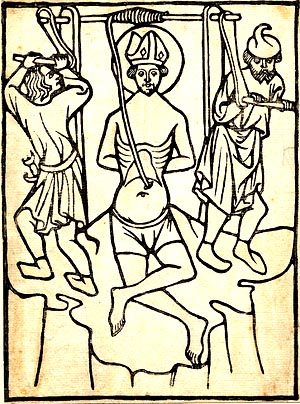 |
|||||||||||||||||||||||||||||||||||
Iron maiden
Inspiration for the "Iron Maiden" may come from the Carthaginian execution of Marcus Atilius Regulus, as it was recorded in a passage in Augustine of Hippo's The City of God (I.15) in which the Carthaginians "packed him into a tight wooden box, spiked with sharp nails on all sides, so that he could not lean in any direction without being pierced".[or by the account of Nabis of Sparta's deadly statue of his wife, the Apega. The legendarium that has accrued to the early 17th-century Countess Elizabeth Báthory features a very similar torture device, which she allegedly dubbed the "iron virgin".The iron maiden is often associated with the Middle Ages, but in fact was not invented until the late 18th century: No account of the iron maiden can be found earlier than 1793. Geoffrey Abbot attributes to a French officer the following account
of discovering such a device in the dungeons beneath the headquarters
of the Inquisition:
The iron maiden of Nuremberg was anthropomorphic. It was probably styled after primitive "Gothic" representations Mary, the mother of Jesus, with a cast likeness of her on the face. The "maiden" was about 7 feet (2.1 m) tall and 3 feet (0.91 m) wide, had double doors, and was big enough to contain an adult man. Inside the tomb-sized container, the iron maiden was fitted with dozens of sharp spikes. Several nineteenth century iron maidens are on display in museums around the world. |
|
|||||||||||||||||||||||||||||||||||
Judas Cradle
The Judas Cradle is often attributed to the Spanish Inquisition The Judas cradle was a tall stool shaped device with a metal or wooden pyramid on top.
Sometimes to prolong torture the victim would be suspended above the device over night, and torture would continue the next morning. The device was rarely, if ever, cleaned. If victims did not die from the device, they almost always died from infection. Torture with the Judas Cradle could last several hours to several days. Apart from the agonising pain one suffered, the humiliation was the primary attraction for this method of torture. Whenever the victim fainted from the pain, the torturer would lift the victim until the tortured person was "awake" again to commence with the process. The Judas Cradle was used in several different countries, each having their own names for it. In Italy it was known as "culla di Giuda", in Germany "Judaswiege", and in France "la veille".It is also known as the Judas Chair. A similar device, known as a horse, is sometimes said to have been used in Prussia to discipline soldiers. This device was not designed to break the skin. |
|
|||||||||||||||||||||||||||||||||||
Mutilation Tools
In England ear lopping was particularly popular. Pamphleteers attacking the religious views of the Anglican episcopacy under William Laud, the Archbishop of Canterbury, had their ears cut off, including Dr. Alexander Leighton (1630) and John Bastwick, Henry Burton and William Prynne (1637). In Scotland a Covenanter, James Gavin of Douglas of Lanarkshire had his ears cut off for refusing to renounce his religious faith.
|
|
|||||||||||||||||||||||||||||||||||
Iron Chair
see Chair of Torture |
||||||||||||||||||||||||||||||||||||
Pear of Anguish
This version of the pear has also been referred to as the "Pear of Confession", the "Pope's Pear" (these due to reports that such devices were used during the Inquisition); the "oral pear", "vaginal pear", or "anal pear"; and just "The Pear". A pear shaped instrument, consisting of four leaves that slowly separated from each other as the torturer turned the screw at the top. This device was used during the Middle Ages as a way to torture women who conducted a miscarriage, liars, blasphemers, and homosexuals. A pear-shaped instrument was inserted into one of the victim's orifices: the vagina for women, the anus for those considered to be male homosexuals, and the mouth for liars and blasphemers. The instrument consisted of four leaves that slowly separated from each other as the torturer turned the screw at the top. It was the torturers decision to simply tear the skin or expand the "pear" to its maximum and mutilate the victim. The Pear of Anguish was usually very adorned to differentiate between the anal, vaginal and oral pears. They also varied in size accordingly.
This torture very rarely caused death, but was often followed by other torture methods. The choke pear (or pear of anguish) is the modern name for a type of instrument displayed in some museums, consisting of a metal body (usually pear-shaped) divided into spoon-like segments that could be spread apart by turning a screw. The museum descriptions and some recent sources assert that the devices were used either as a gag, to prevent people from speaking, or as an instrument of torture. The instrument was inserted into the victim's mouth, and then slowly spread apart as the screw was turned. There is no contemporary first-hand account of those devices or their use. The earliest mention is in F. de Calvi's L'Inventaire général de l'histoire des larrons ("General inventory of the history of thieves"), written in 1639, which attributes the invention to a robber named Capitaine Gaucherou de Palioly in the days of Henry of Navarre. Palioly would have used a mechanical gag to subdue a wealthy Parisian while he and his accomplices robbed the victim's home. Further mentions of the device appear in the 19th century. They are also mentioned in Grose's Dictionary of the Vulgar Tongue (1811) as "Choak Pears," and described as being "formerly used in Holland." There are a number of extant examples of ornate and elaborate, pear-shaped devices with three or four leaves or lobes, driven by turning a key that rotates the central screw thread, which spreads the leaves. |
|
|||||||||||||||||||||||||||||||||||
Peine Forte et Dure
Peine forte et dure (Law French for "hard and forceful punishment") was a method of torture formerly used in the common law legal system, in which a defendant who refused to plead ("stood mute") would be subjected to having heavier and heavier stones placed upon his or her chest until a plea was entered, or as the weight of the stones on the chest became too great for the condemned to breathe, fatal suffocation would occur.
Common law courts originally took a very limited view of their own jurisdiction. They considered themselves to lack jurisdiction over a defendant until he had voluntarily submitted to it by entering a plea seeking judgement from the court. A criminal justice system that punished only those who volunteered for punishment was unworkable; this was the means chosen to coerce them. Many defendants charged with capital offences refused to plead, since by refusing they would escape forfeiture of property, and their heirs would still inherit their estate. If the defendant pleaded guilty and was executed, their heirs would inherit nothing, their property escheating to the Crown. Peine forte et dure was abolished in the Kingdom of Great Britain in 1772, although the last known actual use of the practice was in 1741. In 1772 refusing to plead was deemed to be equivalent to pleading guilty. This was changed in 1827 to being deemed a plea of not guilty. Today, in all common law jurisdictions, standing mute is treated by the courts as equivalent to a plea of not guilty. |
|
|||||||||||||||||||||||||||||||||||
The Picquet
The picquet (alternately spelled piquet) is a form of punishment or torture. A particularly fiendish example is shown on the right where a French Revolutionary woman is being subjected to it. It was more commonly a military punishment in vogue in late medieval Europe that was sufficiently cruel and ingenious to be characterised by some as a method of torture. The punishment of the picquet required extremely simple equipment, a stake with one end in the ground and other, exposed end, facing upward. The exposed end would be sharpened to a rounded point. The malefactor, typically a soldier who had disobeyed orders, had one thumb was suspended from a tree, while the sole of the opposite naked foot was balanced on top of the stake. The point of the stake was sharp enough to jab into the bony interstice and cause considerable discomfort, but not sharp enough to draw blood. To relieve pressure upon the suffering foot, the prisoner relegated all his weight to the thumb, all but tearing the thumb from its socket, which could, in turn, only be relieved by shifting weight onto the tortured foot. The procedure could be continued for as short a duration as a few hours, or as long a duration as twenty-four hours (or even forty-eight during extreme cases). The punishment did not cause lasting harm but was tremendously effective in reminding the sufferer of the supremacy of military discipline. |
|
|||||||||||||||||||||||||||||||||||
Pillory
Like the lesser punishment called the stocks, the pillory consisted of hinged wooden boards that formed holes. In the pillory the head and hands were inserted in these holes. In stocks the feet were inserted. In some variations both hands and feet were inserted. The boards were then locked together to secure the captive. Different pillories could accommodate one, two, three or more people. The word is documented in English since 1274 , and stems from Old French pellori, itself from medieval Latin pilloria, perhaps a diminutive of Latin pila "pillar, stone barrier." Pillories were set up to hold petty criminals outside churches, in marketplaces, crossroads, and other public places. They were often placed on platforms to increase public visibility of the punished offender. Often a placard detailing the crime was placed nearby. These punishments generally lasted only a few hours. Time in the pillory was more dangerous than in the stocks, as the pillory forced the offender to remain standing and exposed. A criminal in the stocks could expect to be abused but his or her life was not targeted. A prisoner in the pillory was presumed to have committed a more serious crime and usually triggered a more aggressive reaction from the public. As part of the punishment, crowds would throw rubbish, ordure and other objects at the captive pilloried offender. With hands trapped, he or she could not avoid thrown objects whether harmless items like rotten food, or injurious ones such as heavy stones, which could and often did result in blinding, permanent maiming, or death. The criminal could also be sentenced to further punishments while in the pillory: humiliation by shaving of some or all hair or regular corporal punishment.. A pillory could also serve as a "whipping post", for birching, caning or permanent mutilation such as branding or having an ear cut off, as in the case of John Bastwick. After 1816, use of the pillory was restricted in England to punishment for perjury or subornation. It was abolished as a form of punishment in England and Wales in 1837, but the stocks remained in use until 1872. The last person to be pilloried in England was Peter James Bossy, who was convicted of "wilful and corrupt perjury" in 1830. He was offered the choice of seven years transportation or one hour in the pillory, and chose the latter. In France, time in the "pilori" was usually limited to two hours. It was replaced in 1789 by "exposition", and abolished in 1832. The poteau was a simple post, often with a board around only the neck, and was synonymous with the mode of punishment. This was the same as the schandpaal ("shamepole") in Dutch. The carcan, an iron ring around the neck to tie a prisoner to such a post, was the name of a similar punishment that was abolished in 1832. A criminal convicted to serve time in a prison or galleys would, prior to his incarceration, be attached for two to six hours (depending on whether he was convicted to prison or the galleys) to the carcan, with his name, crime and sentence written on a board over his head. A permanent small tower, the upper floor of which had a ring made of wood or iron with holes for the victim's head and arms, which was often on a turntable to expose the condemned to all parts of the crowd. Like other permanent apparatus for physical punishment, the pillory was often placed prominently and constructed more elaborately than necessary. It served as a symbol of the power of the judicial authorities, and its presence was a deterrent, like permanent gallows or a gibbet. In Portugal several pelourinhos, typically on the main square or in front of a major church or palace, are now counted among the major local monuments, several bearing the emblems of a king or queen. In Spain it was called picota. There was a variant, called a barrel pillory, or Spanish mantle, used to punish drunks. It fitted over the entire body, with the head sticking out from a hole in the top. The criminal was put in either an enclosed barrel, forcing him to kneel in his own filth, or an open barrel, also known as "barrel shirt" or "drunkards collar" after the punishable crime, leaving him to roam about town or military camp and be ridiculed and scorned. Another variant was the finger pillory, in which a person could be trapped by locking a bent finger in it.
|
|
|||||||||||||||||||||||||||||||||||
Pressing
|
||||||||||||||||||||||||||||||||||||
The Rack
The rack is a torture device that consists of an rectangular, usually wooden frame, raised from the ground, with a roller at one end or both ends, having at one end a fixed bar to which the legs were fastened, and at the other a movable bar to which the hands were tied. The victim's feet were fastened to one roller, and the wrists chained to the other.
The torturer turned a handle causing the ropes to pull the victim's arms. Eventually, the victim's bones were dislocated with a loud crack, caused by snapping cartilage, ligaments or bones. If the torturer kept turning the handles the limbs would eventually be torn off. This method was mostly used to extract confessions, not confessing meant that the torturer could stretch more. Sometimes, torturers forced their victim to watch other people be tortured with this device to implant psychological fear. Many Knights Templar were tortured with the rack. The limbs collected from this and other punishments of the time were "emptied by the hundreds". Sometime this method was limited to dislocating a few bones, but the torturer often went too far and rendered the legs or arms (sometimes both) useless. In the late Middle Ages, some new variants of this instrument appeared. They often had spikes that penetrated the victim's back - as the limbs were pulled apart, so was his or her spinal cord increasing not only in physical pain, but the psychological one of being handicapped.
As the interrogation progresses, a handle and ratchet attached to the top roller are used to very gradually stepwise increase the tension on the chains, inducing excruciating pain. By means of pulleys and levers this roller could be rotated on its own axis, thus straining the ropes until the sufferer's joints were dislocated and eventually separated. If muscle fibres are stretched excessively, they lose their ability to contract, rendering them ineffective. One gruesome aspect of being stretched too far on the rack is the loud popping noises made by snapping cartilage, ligaments, or bones. One powerful method for putting pressure upon prisoners was to force them to watch someone else being subjected to the rack. A crueller variant of the rack included a rotating drum studded with spikes. The prisoner was tied face-down to this rack; as he was stretched, the rotation of the spiked roller against his abdomen gradually disembowelled and killed him. Confining the prisoner on the rack enabled further tortures to be applied, typically including burning the flanks with hot torches or candles or using pincers with specially roughened grips to tear out the nails of the fingers and toes. Its first employment in England is said to have been due to John Holland, 2nd Duke of Exeter, the Constable of the Tower in 1447, whence it was popularly known as the Duke of Exeter's daughter. Being tortured on the rack was often referred to as being "put to the question". In 1628 the question of its legality was raised by the attempt of the Privy Council to rack John Felton, the assassin of the Duke of Buckingham. The judges , unanimously declared its use to be contrary to the laws of England. Well known victims of the rack in England include Guy Fawkes, Edmund Campion and Anne Askew, venerable William Carter (1584), Elizabethan dramatist Thomas Kyd (1592), William Wallace and Jesuit lay-brother Saint Nicholas Owen (1606). The French introduced an "improvement" to the rack in the form of spiked rollers that were inserted under the spine of the victim, thus causing even more severe pain and damage.
The Inquisition used the rack as one of its chief weapons of torture. The term rack is also used, occasionally, for a number of simpler constructions that merely facilitate corporal punishment, after which it may be named specifically, e.g., caning rack. Several devices similar in principle to the rack have been used through the ages. One of these was the Wooden Horse, a device used to torture prisoners during the Roman Empire by stretching them on top of a tall wooden frame until the shoulders were dislocated followed by a violent drop into a hanging position and beating. In another variant used primarily in ancient times, the victim's feet were fixed to the ground and his/her hands were chained to a wheel. When the wheel was turned, the person was stretched in a manner similar to the rack. The Austrian Ladder was basically a more vertically oriented rack. As part of the torture, victims would usually be burned under the arms with candles.
|
|
|||||||||||||||||||||||||||||||||||
Rats
A cheap and effective way to torture someone was with rats. There were many variants, but the most common was to force a rat through a victim's body (usually the intestines) as a way to escape. This was done as follows: The victim was completely restrained usually being tied to the ground or any horizontal surface. He would then have slits cut in his belly. Hungry rats would then be placed in the slits to eat the victim from the inside. Gnawing the intestines usually took hours or days of agonising pain for the victim. Unless stopped almost immediately this torture always resulted in eventual death (through peritonitis if nothing qhicker intervened). |
|
|||||||||||||||||||||||||||||||||||
Sawing
Sawing is a method of torture and execution. The victim was hung upside down and then sawed apart down the middle, starting at the groin. Since the condemned was hanging upside-down, the brain received a continuous blood supply in spite of the severe bleeding. They would remain conscious until the saw severed the major blood vessels of the abdomen, and sometimes even longer.
|
|
|||||||||||||||||||||||||||||||||||
Scavenger's Daughter
The Scavenger's Daughter was conceived as a complement to the Duke of Exeter's Daughter (the rack) because it worked the opposite principle to the rack by compressing the body rather than stretching it. The Scavenger's Daughter is rarely mentioned in the documents and the device itself was probably not much used. The bestt-documented use is that on the Irishman Thomas Miagh, charged with being in contact with rebels in Ireland. It may be in connection with Scavenger's Daughter that Miagh carved on the wall of the Beauchamp Tower in the Tower of London, "By torture straynge my truth was tried, yet of my libertie denied. 1581. Thomas Miagh." Another victim of the Scavenger's Daughter was Thomas Cottam, from Lancashire who was executed for treason during the reign of Elizabeth I. It is also known as Skevington's gyves, as iron shackle, as the Stork (as in Italian cicogna) or as Spanish A-frame. Further it is known as Skevington's daughter, from which the more commonly known folk etymology using "Scavenger" is derived. A Scavenger's daughter is on display in the Tower of London museum. |
|
|||||||||||||||||||||||||||||||||||
Spike
|
||||||||||||||||||||||||||||||||||||
Stocks
The stocks are similar to the pillory and the pranger, as each consists of large, hinged, wooden boards. The difference is that when a person is placed in the stocks, their feet are locked in place, and sometimes as well their hands or head, or these may be chained. With stocks, boards are placed around the legs or the wrists, whereas in the pillory they are placed around the arms and neck and fixed to a pole, and the victim stands. Since stocks served an outdoor public form of punishment its victims were subjected to the daily and nightly weather. It was not uncommon for people kept in stocks over several days in winter to die of hypothermia.
An fellon in the stocks might expect the punishment to be complemented by tickling, verbal Insults, rotten food, kicking, spitting, urinating and defecating. An unpopular one could expect whipping, bastinado or even to be stoned to death. Fellons in the stocks for a prolonged period would receive only bread and water, plus anything brought by their friends. Public stocks were typically positioned in the most public place available, as public humiliation was a critical aspect of such punishment. The stocks were popular among civil authorities from medieval to early modern times. They were widely used in Elizabethan England, and by the Puritans in the colonial period of American history. Their last recorded use in the United Kingdom was in 1872 at Adpar, Newcastle Emlyn, west Wales. Spanish conquistadores introduced stocks as a form of punishment and humiliation against those that impeded the consolidation of Christian settlements in the new world. They were still used in the 19th century in Latin America. They are occasionally preserved in churches. Finger pillories often went by the name of "finger stocks". |
|
|||||||||||||||||||||||||||||||||||
Strappado
Strappado is a form of torture in which the victim's hands are first tied behind his back, and then he is suspended in the air by means of a rope attached to wrists, which most likely dislocates both arms. Weights may be added to the body to intensify the effect and increase the pain. Other names for strappado include "reverse hanging" It is best known for its use in the torture chambers of the medieval Inquisition. There are three variants of this torture. In the first one, the victim has his or her arms tied behind their back; a large rope is then tied to the wrists and passed over a pulley, beam or a hook on the roof. The torturer pulls on this rope until the victim is hanging from the arms. Since the hands are tied behind the victim's back, this will cause a very intense pain and possible dislocation of the arms. The full weight of the subject's body is then supported by the extended and internally-rotated shoulder sockets. While the technique shows no external injuries, it can cause long-term nerve, ligament, or tendon damage. The technique typically causes brachial plexus injury, leading to paralysis or loss of sensation in the arms. The second variation is similar to the first, but a series of drops is added, meaning that the victim is allowed to drop until his or her fall is suddenly checked by the rope. In addition to the damage caused by the suspension, the painful jerk would cause major stress to the extended and vulnerable arms, leading to broken shoulders. In the third variant, the victim's hands are tied to the front. The victim is also hung from the hands, but the ankles are tied and a heavy weight is attached to them. This will cause pain and possible damage not only to the arms, but also to the legs and hips. This variant was known as "squassation".
The second variation with arms tied behind the back and with repeated drops was the favoured method of the Medieval and Spanish Inquisitions. According to William Godwin, Savonarola was tortured by strappado multiple times before being put to death in a trial by fire; Savonarola apparently renounced his confessions after being tortured. It is believed that Niccolň Machiavelli, during his 1513 imprisonment after allegedly conspiring against the Medici family in Florence, was also subjected to this form of strappado. |
|
|||||||||||||||||||||||||||||||||||
Tablilla
The medieval Spanish tablillas, was an instrument of torture used to crush toes. The prisoner was bound face-upward to the rack and stretched until the tension in his bare feet held his toes tense and stiffly pointed. The tablillas were essentially a pair of pillories for the feet - two small wooden tablets featuring five narrow holes through which the toes were forced and immobilised. Before putting each question, the torturer positioned a sharp wedge of hard wood over the tip of one of the prisoner's toes. If he found the answer unsatisfactory, the torturer sharply struck the wedge with a heavy mallet, driving the wedge head-on into the toe with sufficient force to obliterate the tiny bones. The toes were destroyed one by one, ranging upward in size from the smallest toes to the great toes. While the tablillas could theoretically be applied to the fingers as well, the results were inferior: long, thin fingers were more likely merely to snap under the wedge while short, stubby toes were more readily pulverised. The pudgier the prisoner's toes, the stronger his candidacy for successful torture by the tablillas. |
|
|||||||||||||||||||||||||||||||||||
|
|
||||||||||||||||||||||||||||||||||||
Tarring and Feathering
Tarring and feathering is a physical punishment, used to enforce formal justice. It was used in feudal Europe and its colonies in the early modern period In a typical tar-and-feathers attack, the subject of a crowd's anger would be stripped to his waist. Hot tar was poured or painted onto the person while he was immobilised. Then the victim either had feathers thrown on him or was rolled around on a pile of feathers so that they stuck to the sticky tar. Often the victim was paraded around town on a cart or a rail. The aim was to inflict enough pain and humiliation on a person to cause him to either reform his behaviour or leave town. Sometimes only the head was shaven, tarred and feathered. In some cases a match was held to the feathers to light them, as well as the tar, on fire to inflict pain. The earliest mention of the punishment occurs in the orders of Richard I of England, issued to his navy on starting for the Holy Land in 1189.
A later instance of this penalty being inflicted is given in Notes and Queries (series 4, vol. v), which quotes one James Howell writing from Madrid, in 1623, of the "boisterous Bishop of Halberstadt", who, "having taken a place where there were two monasteries of nuns and friars, he caused divers feather beds to be ripped, and all the feathers thrown into a great hall, whither the nuns and friars were thrust naked with their bodies oiled and pitched and to tumble among these feathers, which makes them here (Madrid) presage him an ill-death." During the night of March 24, 1832, Joseph Smith, Jr., the leader of The Church of Jesus Christ of Latter-day Saints, was dragged from his home by a group of men who stripped and beat him before tarring and feathering him. Smith was left for dead, but he limped to the home of friends who spent much of the night scraping the tar from his body, leaving his skin raw and bloody. In 1851 a mob in Ellsworth, Maine tarred and feathered a Swiss-born Jesuit priest, Father John Bapst, in the midst of a local controversy over religious education in grammar schools. The punishment was also used by the IRA in Northern Ireland in the Twentieth century. |
|
|||||||||||||||||||||||||||||||||||
Thumbscrews
The thumbscrews or pilliwinks is a torture instrument which was first used in medieval Europe. It is a simple vice, sometimes with protruding studs on the interior surfaces. The victim's thumbs or fingers were placed in the vice and slowly crushed.
The crushing bars were sometimes lined with sharp metal points to puncture the nails and inflict greater pain in the nail beds. Larger, heavier devices based on the same design principle were applied to crush knees and elbows. The pilliwinks used for this purpose probably differed from thumbscrews by squeezing the fingers. According to the Tudor historian Eric Ives, Anne Boleyn sent a pilliwinks to the nursemaid looking after her daughter, the future Elizabeth I.
|
|
|||||||||||||||||||||||||||||||||||
Water Cure (Water Torture)
Often the victim has the mouth forced or wedged open, the nose closed with pincers and a funnel or strip of cloth forced down the throat. The victim has to drink all the water (or other liquids such as bile or urine) poured into the funnel to avoid drowning. The stomach fills until near bursting, and the victim is sometimes beaten until the victim vomits. The torture then begins again. While this use of water as a form of torture is documented back to at least the 15th century, the first use of the term Water Cure in this sense is indirectly dated to around 1898, by U.S. soldiers in the Spanish-American war.
The French poet and criminal François Villon was subjected to this torture in 1461. Jean Calas suffered this torture before being broken on the wheel in 1762. The true case of the Marquise of Brinvilliers was reported in fiction by Arthur Conan Doyle in "The Leather Funnel", by Alexandre Dumas, pčre in "The Marquise de Brinvilliers" and by Émile Gaboriau in "Intrigues of a Poisoner". A form of water cure known as the Swedish drink was used by various international troops in the German states during the Thirty Years' War. Water cure was among the forms of torture used by the Spanish Inquisition. The Inquisition at Málaga subjected the Scottish traveller William Lithgow to this torture, among other methods, in 1620. He described his ordeal in Rare Adventures and Painful Peregrinations (1632):
Before pouring the water, torturers often inserted an iron prong (known as the bostezo) into a victim's mouth to keep it open, as well as a strip of linen (known as the toca) on which the victim would choke and suffocate while swallowing the water. This form of torture was famously used in the twenty-first century by American agents as a way of extracting information and confessions from suspected Islamic terrorists.
|
|
|||||||||||||||||||||||||||||||||||
Wheel or Breaking Wheel or Catherine Wheel
The breaking wheel was a torturous capital punishment device used in the Middle Ages and early modern times for public execution by cudgelling to death, especially in France and Germany. In France the condemned were placed on a cart-wheel with their limbs stretched out along the spokes over two sturdy wooden beams. The wheel was made to slowly revolve. Through the openings between the spokes, the executioner hit the victim with an iron hammer that could easily break the victim's bones. This process was repeated several times per limb. Once his bones were broken, he was left on the wheel to die. It could take hours, even days, before shock and dehydration caused death. The punishment was abolished in Germany as late as 1827. Less severe offenders would be cudgelled 'top down', with the first blow to the neck, causing death; more heinous criminals were punished 'bottom up', starting with the legs, and sometimes being beaten for hours. The number and sequence of blows was specified in the court's sentence. Corpses were left for carrion-eaters, and the criminals' heads often placed on a spike. The wheel used in France, Germany, Denmark, Sweden, Romania, Russia, Greece, Spain, Portugal, and other countries. It was typically a large wooden wagon wheel with radial spokes, but a wheel was not always used. The condemned was sometimes spread-eagled and broken on a St Andrew's cross consisting of two wooden beams nailed in an "X" shape, after which the victim's mangled body might be displayed on the wheel. The condemned's shattered limbs were woven ('braiden') through the spokes of the wheel, which was then hoisted onto a tall pole so that birds could eat the sometimes still-living individual. In France, the condemned were placed on a cartwheel with their limbs stretched out along the spokes over two sturdy wooden beams. The wheel was made to revolve slowly, and a large hammer or an iron bar was then applied to the limb over the gap between the beams, breaking the bones. This process was repeated several times per limb. Sometimes it was 'mercifully' ordered that the executioner should strike the criminal on the chest and stomach, blows known as coups de grâce (French: "blows of mercy"), which caused fatal injuries. Without those, the broken man could last hours and even days, before shock and dehydration caused death. In France, a special grace, the retentum, could be granted, by which the condemned was strangled after the second or third blow, or in special cases, even before the breaking began. In the Holy Roman Empire, the wheel was punishment reserved primarily for men convicted of aggravated murder (murder committed during another crime, or against a family member) or for belonging to a Christian denomination other than the Catholic Church. The wheel was sometimes called a Catherine Wheel, because of a fictitious story that St. Catherine of Alexandria was executed on one of these devices. The story seems to be a mangled version of the murder of Hypatia of Alexandria by an early Christian mob.
In Scotland, a servant named Robert Weir was broken on the wheel at Edinburgh in 1603. This punishment had hardly ever been used before in that country. The crime had been the murder of John Kincaid, Lord of Warriston on behalf of his wife. Weir was secured to a cart wheel and was struck and broken with the coulter of a plough. The breaking wheel was used in Germany as recently as the early 19th century for the crime of parricide, and the last known use occurred in 1841 when the assassin of the Bishop of Ermeland in Prussia was executed in this manner.. |
|
|||||||||||||||||||||||||||||||||||
Wooden horse
A wooden horse (or Spanish donkey) is a torture device, of which there exist two variations. The first is a sharply angled device with the sharp point of the angle pointing upward, mounted on a saw-horse like support. The victim is made to straddle the triangular "horse" and place their full body weight on their genitals, which rested on the point of the angle. Weights or additional restraints were often added to keep the victim from falling off. A punishment similar to this was used during the American colonial period and later. Called Riding the Rail, the victim was often carried through town in this predicament, often in conjunction with the punishment of tarring and feathering. The crotch can be injured and the victim could be left unable to walk without pain. A less immediately painful variation, often dubbed the wooden pony, is a single plank of wood supported (either again with wooden legs or suspended from the ceiling) horizontal from the floor on its side, with the thin edge up. Usually this edge is filed to a blunt point or rounded off. The victim is made to straddle the plank, which is adjusted (raised or lowered) in order to make the victim stand on his tiptoes or rest his body weight on his genitals on the plank. |
|
|||||||||||||||||||||||||||||||||||
Psychological torture
Psychological torture uses non-physical methods that cause psychological suffering. Its effects are not immediately apparent unless they alter the behaviour of the tortured person. Since there is no international political consensus on what constitutes psychological torture, it is often overlooked, denied, and referred to by different names. Psychological torture is less well known than physical torture and tends to be subtle and much easier to conceal. In practice the distinctions between physical and psychological torture are often blurred. Physical torture is the inflicting of severe pain or suffering on a person. In contrast, psychological torture is directed at the psyche with calculated violations of psychological needs, along with deep damage to psychological structures and the breakage of beliefs underpinning normal sanity. Torturers often inflict both types of torture in combination to compound the associated effects. Psychological torture includes deliberate use of extreme stressors and situations such as mock execution, shunning, violation of deep-seated social or sexual norms and taboos, or extended solitary confinement. Because psychological torture needs no physical violence to be effective, it is possible to induce severe psychological pain, suffering, and trauma with no externally visible effects. Rape and other forms of sexual abuse were and still are often used as methods of torture for interrogative or punitive purposes. |
|
|||||||||||||||||||||||||||||||||||
Torture Chambers
The torture chamber was specifically designed to evoke fear in the victims. It was usually built underground and only dimly lit. Inside the chamber waited the executioner, his face covered and wearing a black hood. When the sight of the chamber, the torture instruments and the executioner did not cause the victim to confess, a full-scale torture session was initiated. During the Inquisition, the method of construction of the torture chamber of the papal palace at Avignon has been described as ingenious. The walls of the torture chamber were constructed in such a manner as to project the shrieks of the tortured from wall to wall, without ever reaching the outside. The chamber where the victims were being burnt was of circular construction and resembled the furnace of a glass-house with a funnel-like chimney at the top. Up to 1850 the chambers were shown to visitors after which time the ecclesiastical authorities of Avignon decided to shut them down. The torture chamber of the Spanish Inquisition in Lima, Peru had one metre thick walls so that the screams of the victims could not penetrate them. In Nuremberg and Salzburg torture chambers featured trapdoors on their floors. In Nuremberg the room underneath the main torture chamber featured torture machinery while in Salzburg, the room under the trapdoor, functioned like a waiting room for prisoners. When the time came the prisoner was pulled up and into the upper torture chamber. In some places, deep water pits could be found under the trapdoor, where the victims of the torture chamber could be thrown, after a torture session, to drown. The torture chamber was the final destination in a progression of four cell types during incarceration at the Palace of the Inquisition. The palace contained the Judgement Hall, the offices of the employees, the private apartments of the Grand Inquisitor and the detention cells adjacent to the apartments. The detention cell gradations started with the cells of mercy reserved mainly for rich transgressors who upon bequeathing all their property to the Inquisition were normally let go after a time of detention in the cells. For more difficult prisoners the next cell stage was the cell of penitence. These were situated in small round towers of about 3 metres (ten feet) in diameter. They were painted white and included rudimentary furniture such as a stool and a bed. Very little light was allowed in. If the prisoner did not co-operate, the next step in the detention process was the dungeon. The dungeon had walls 1.5 metres (five feet) thick, double doors and was in complete darkness. No conversation of any type was allowed in the dungeon. The food allowance for prisoners was less than a penny a day including the profit of the warden while any human refuse was removed every four days. After a stay in the dungeon, uncooperative prisoners were moved to the torture chamber. One of the oddities of history is that today many castles buy old torture equipment to attract visitors to their cellars so that they can be presented as torture chambers. By contrast the overwhelming majority of genuine torture chambers, owned and operated by the Church, are closed to the public, their equipment destroyed or sold off, and their very existence implicitly denied, presumably because the scale of torture sanctioned by the Church over many centuries is difficult to justify in a secular age. |
|
|||||||||||||||||||||||||||||||||||
Effects of torture
For survivors, torture often leads to lasting mental and physical health problems. Victims were permanently mutilated, crippled or disfigured. Prolonged confinement in a scavenger's daughter would render the victim permanently unable to stand up. The consequences of torture reach far beyond immediate pain. Victims suffer from post-traumatic stress disorder, with symptoms such as flashbacks or intrusive thoughts, severe anxiety, insomnia, nightmares, depression and memory lapses. Torture victims often feel guilt and shame, triggered by the humiliation they have endured. Many feel that they have betrayed themselves or their friends and family. Such symptoms are normal human responses to abnormal and inhuman treatment. Physical problems can be wide-ranging, and include sexually transmitted diseases, musculo-skeletal problems, brain injury, post-traumatic epilepsy and dementia or chronic pain syndromes. Mental health problems are equally wide-ranging. Common are post-traumatic stress disorder, depression and anxiety disorder. |
|
|||||||||||||||||||||||||||||||||||
|
Torture and the Christian Church
The Christian Churches, and especially the Catholic Church, not only practised torture, they also provided the moral underpinning for its use, and pioneered new techniques. The papal Inquisitions were by far and away the most prolific and proficient torturers for many centuries. They codified rules for the application of torture but it is not clear why, since they routinely ignored all restrictions: for example they tortured children, they carried out repeated tortures, and they accepted as evidence the sort of tittle-tattle that no civil court would countenance. Whenever they broke the rules they were empowered to forgive each other. Instruments of torture were regularly blessed and sprinkled with holy water. Under the influence of increasing secular western society, the Catholic Church abandoned the use of torture in the nineteenth century. Today the Catechism of the Catholic Church condemns the use of torture. In No. 2297-2298 it states:
Despite first appearances, this is not an unconditional condemnation of torture. For example it does not condemn the use of torture to extract information such as the names of accomplices. Neither does it recognise that the Church was responsible for the deaths of countless thousands of people who were wholly innocent, or whose crimes would not today attract so much as a small fine. One of the many mass witch hunts, and possibly the worst, was that at Bamburg in Germany. In many ways it was typical.
Bamberg witch trialsBamberg witch trials took place in Bamberg in Germany in 1626-1631. They resulted in the deaths of between 300 and 600, one of the greatest mass executions in peace time. The Bamberg Witch Trials erupted during a period of a series of mass witch trials in the area of Southern Germany, contemporary with the Würzburg witch trials and others. The witch craze of the 1620s was not confined to Germany, but influenced Alsace, Lorraine and Franche-Comté: in the lands of the abbey of Luxueil the years 1628-30 have been described as a demonic epidemic. The area around Bamburg had been devastated by war and conflicts within the Holy Roman Empire, as well as a series of crop failures, famines and plagues. The Church looked for supernatural explanations, and accusations of witchcraft proliferated. Bamberg at the time was a small state ruled by the Prince-Bishop Gottfried Johann Georg II Fuchs von Dornheim, who took a leading role in the persecutions. He earned the nickname Hexenbischof or "Witch-bishop." The prince bishop built a "witch-house," complete with torture-chamber adorned with appropriate biblical texts. The Bamberg witch trials have been described as possibly the worst of the period. The bishop's chancellor, Dr. Haan, was burnt for showing suspicious leniency as a judge. He confessed to having seen five burgomasters of Bamberg at the sabbat, and they too were duly burnt: one of the was Johannes Junius, perhaps most known of the many victims of the Bamberg witch trials, whose testemony of the torture he was exposed to became famous.
Johannes JuniusJohannes Junius (1573 - August 6, 1628) was the Burgomeister of Bamberg, who wrote a letter to his daughter from jail while he awaited execution for witchcraft during the Bamberg witch trials. Junius became Burgomeister in 1608 and remained in that position until his arrest, which came shortly after his wife had been executed on similar charges. He was implicated in witchcraft by other victims of the witch craze, who had been pressured under torture to reveal the names of their accomplices. Court documents describe how Junius at first denied all charges and demanded to confront his witnesses, and continued to deny his involvement in witchcraft after almost a week of torture, which included the application of thumbscrews, leg vices (Beinschrauben), and the strappado. He finally confessed on July 5, 1628, and was publicly burned to death one month later. On July 24, shortly before his execution, Junius managed to write a letter to his daughter, Veronica, which was smuggled out of jail by his guard and successfully delivered. In the letter he defends his innocence, claims that those who testified against him have secretly begged his forgiveness, and recounts the abject horror of his torture (inflicted on him by his own brother-in-law and three others). He also says that at first he attempted to create a confession in which he could not identify the other witches, but was forced to name names under threat of further torture. Here is an English translation of his famous heartbreaking letter:
|
|
|||||||||||||||||||||||||||||||||||
Decline of Routine Torture
In the early modern period, the torture of witches became commonplace. Countless people were targeted and tortured for imaginary relationships with the devil. In England the trial by jury developed considerable freedom in evaluating evidence and condemning on circumstantial evidence, making torture to extort confessions unnecessary. For this reason in England a regularise system of judicial torture never existed and its use was limited to political cases, except under the short-lived Puritan regime. When the papacy was trying to find (or create) evidence against the Knights Templar, it encouraged monarchs throughout Europe to torture Templars to gain confessions. Torture was applied and the confessions obtained in most countries, but His Holiness was shocked to discover that the civil authorities in England were not prepared to apply torture. When two Inquisitors were sent to England in 1310 to extract confessions from Knights Templars, they insisted on using torture . The king allowed some torture to be applied "according to ecclesiastical law", but apparently not enough to satisfy the Inquisitors. The Pope wrote to the King:
(Letter from Pope Clement V to King Edward II of England. Regestum Clementis Papae V, nunc primum editum cura et studio Monachorum Ordinis S. Benedicti, (Rome, 1885-92) year 5, no. 6670, pp 84-6. . The English translation is quoted from G. G. Coulton, Medieval Panorama, (CUP, 1947) p 380. Although torture was not permitted under English Common law, in Tudor and early Stuart times it was applied, with the King's warrant, under certain conditions. The confession of Marc Smeaton at the trial of Anne Boleyn was presented in written form only, perhaps to hide from the court that Smeaton had been tortured on the rack for four hours, or because Thomas Cromwell was worried that he would recant his confession if cross-examined. When Guy Fawkes was arrested for his role in the Gunpowder Plot of 1605 he was tortured until he revealed everything he knew about the plot. This was not so much to extract a confession, which was not needed to prove his guilt, but to extract from him the names of his fellow conspirators. By this time a special warrant from King James I was needed before he could be tortured. The wording of the warrant shows concerns for humanitarian considerations, the severity of the methods of interrogation were to be increased gradually until the interrogators were sure that Fawkes had told all he knew. In the end this did not help Fawkes much as he was broken on the only rack in England, in the Tower of London. Torture was abolished in England around 1640 (except peine forte et dure, which was abolished in 1772). In 1613 Anton Praetorius described the situation of the prisoners in the dungeons in his book Gründlicher Bericht Von Zauberey und Zauberern (Thorough Report about Sorcery and Sorcerers). He was one of the first to protest against all means of torture. In the 17th century the number of incidents of judicial torture decreased in many European regions. Johann Graefe in 1624 published Tribunal Reformation, a case against torture. In 1764 Cesare Beccaria, an Italian lawyer, published "An Essay on Crimes and Punishments", in which he argued that torture unjustly punished the innocent and should be unnecessary in proving guilt. Voltaire (1694-1778) also fiercely condemned torture. While in Egypt in 1798, Napoleon Bonaparte wrote to Major-General
Berthier that the European states abolished torture from their statutory law in the late eighteenth and early nineteenth centuries. Sweden and Prussia was the first to do it in 1722 and 1754, respectively; Denmark abolished it in 1770, Austria in 1776, France in 1780, and the Netherlands in 1798. Russia abolished torture in 1801. Bavaria did it in 1806 and Württemburg in 1809. In Spain the Napoleonic conquest put an end to the torture in 1808. Norway abolished it in 1819 and Portugal in 1826. Swiss cantons abolished torture in the first half of the nineteenth century. Some forms of torture, most notably Water Boarding, a form of Water Torture was re-introduced by the USA in the Twenty First Century. |
|
|||||||||||||||||||||||||||||||||||
|
|
|
|||||||||||||||||||||||||||||||||||
| MEDIEVAL WARFARE |
MEDIEVAL WEAPONS |
CRUSADES & CRUSADERS |
WILLIAM MARSHAL |
MEDIEVAL LIFE |
MEDIEVAL TORTURE |
| :::: Link to us :::: Medieval Warfare Resources ::: © C&MH 2010 ::: contact@medievalwarfare.info ::: |
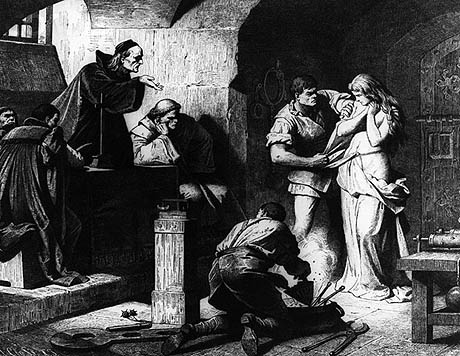
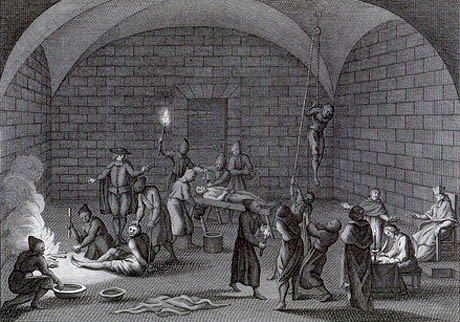
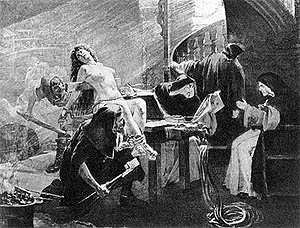
.jpg)
.jpg)
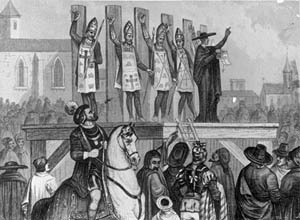

 Torture
devices can be classified in many ways.
Torture
devices can be classified in many ways.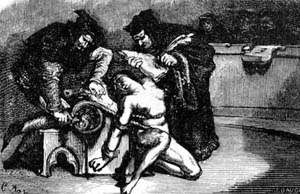
.jpg)
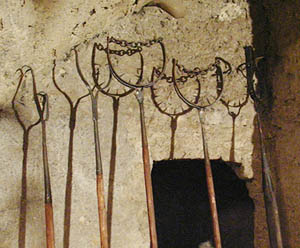

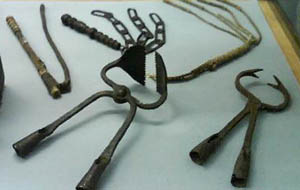
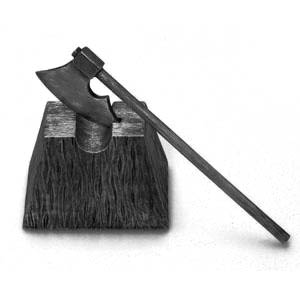 If
the headsman's axe or sword was sharp and his aim true, decapitation
was quick and presumed to be a painless form of death. If the instrument
was blunt or the executioner clumsy, multiple strokes might be required.
The person to be executed was therefore advised to give a gold coin
to the headsman to ensure that he did his job with care. Robert
Devereux, 2nd Earl of Essex, and Mary, Queen of Scots, both required
three strikes at their executions. Margaret Pole, 8th Countess of
Salisbury, required ten strokes before being dispatched by a fatal
blow.
If
the headsman's axe or sword was sharp and his aim true, decapitation
was quick and presumed to be a painless form of death. If the instrument
was blunt or the executioner clumsy, multiple strokes might be required.
The person to be executed was therefore advised to give a gold coin
to the headsman to ensure that he did his job with care. Robert
Devereux, 2nd Earl of Essex, and Mary, Queen of Scots, both required
three strikes at their executions. Margaret Pole, 8th Countess of
Salisbury, required ten strokes before being dispatched by a fatal
blow.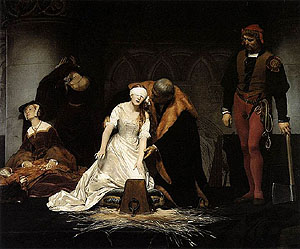
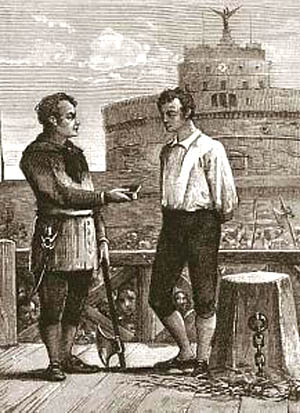
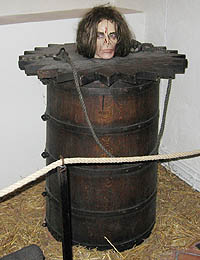 A
barrel is fitted over the entire body, with the head sticking out
from a hole in the top. The person is kept locked in the barrel,
forcing him to kneel in his own filth, and in some cases suffer
extremes of hot or cold.
A
barrel is fitted over the entire body, with the head sticking out
from a hole in the top. The person is kept locked in the barrel,
forcing him to kneel in his own filth, and in some cases suffer
extremes of hot or cold.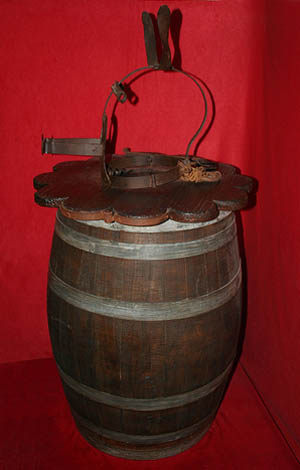
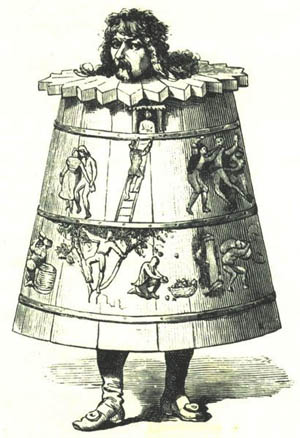
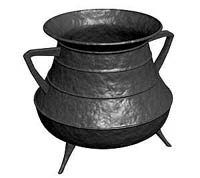 A
large Cauldron was filled with water, oil, tar, tallow or molten
lead. The liquid was then boiled. Sometimes the victim would be
placed in the cauldron before it was boiled so as to be cooked slowly.
Or they would be placed, usually head first, into the already boiling
liquid.
A
large Cauldron was filled with water, oil, tar, tallow or molten
lead. The liquid was then boiled. Sometimes the victim would be
placed in the cauldron before it was boiled so as to be cooked slowly.
Or they would be placed, usually head first, into the already boiling
liquid.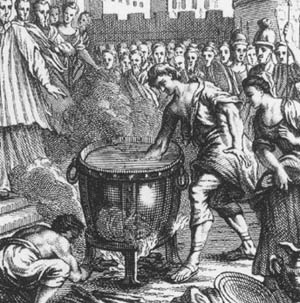
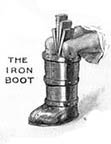 The
Spanish boot was an iron casing for the leg and foot. Wedges were
hammered in between the casing and the victim's flesh. A similar
device, commonly referred to as a shin crusher, squeezed the calf
between two curved iron plates, studded with spikes, teeth, and
knobs, to fracture the tibia and fibula.
The
Spanish boot was an iron casing for the leg and foot. Wedges were
hammered in between the casing and the victim's flesh. A similar
device, commonly referred to as a shin crusher, squeezed the calf
between two curved iron plates, studded with spikes, teeth, and
knobs, to fracture the tibia and fibula.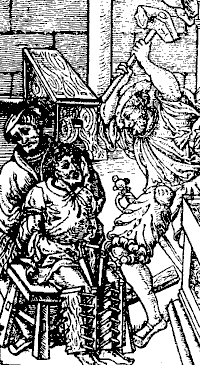
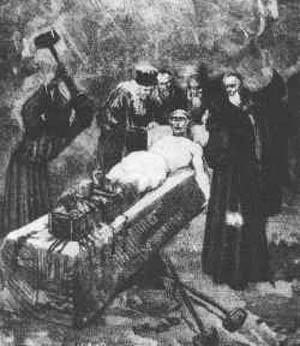
 The
instep borer was a medieval German instrument of torture that externally
resembled an iron boot. It was hinged to permit the insertion and
removal of the bare foot.
The
instep borer was a medieval German instrument of torture that externally
resembled an iron boot. It was hinged to permit the insertion and
removal of the bare foot. 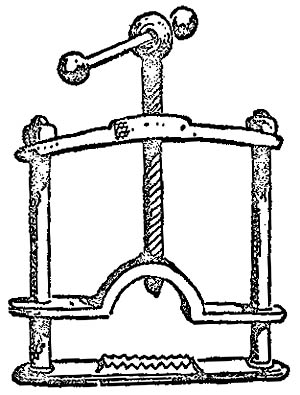
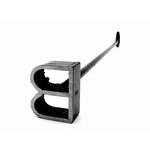

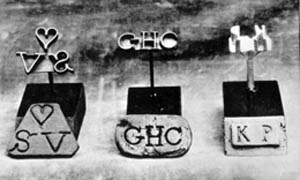
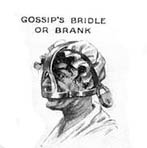 Branks
were used to punish nagging, slander, cursing, witchcraft and criticism
of Christianity.
Branks
were used to punish nagging, slander, cursing, witchcraft and criticism
of Christianity.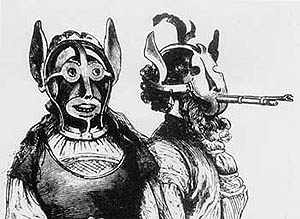
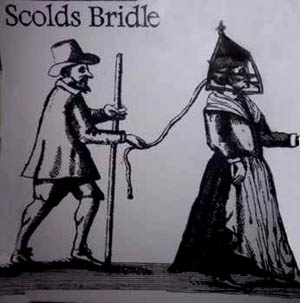
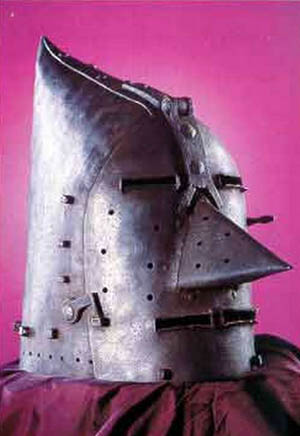
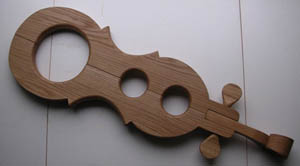
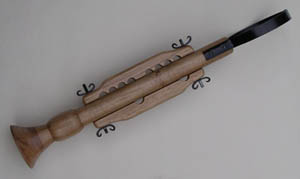
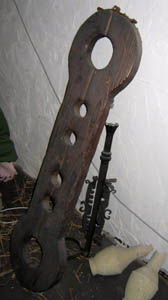
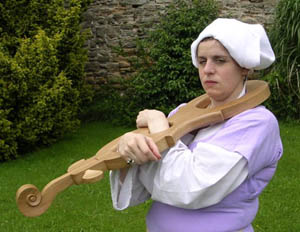
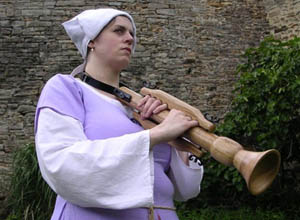

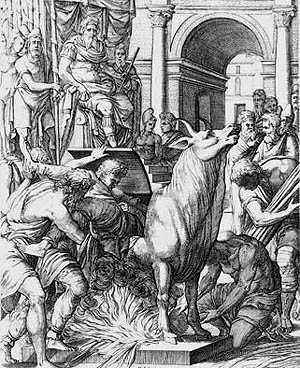
.jpg)

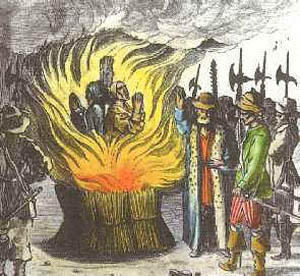
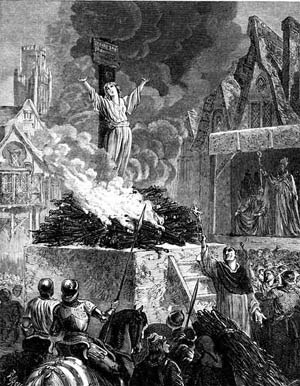
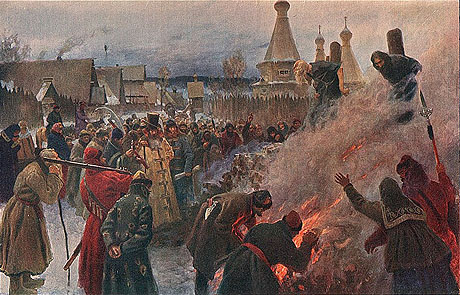
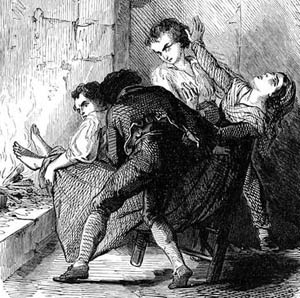
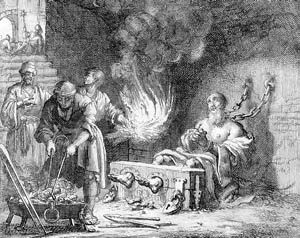
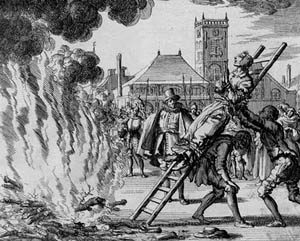
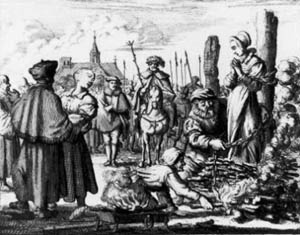
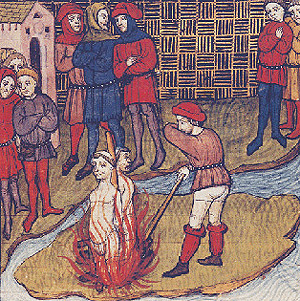
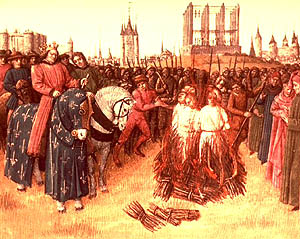
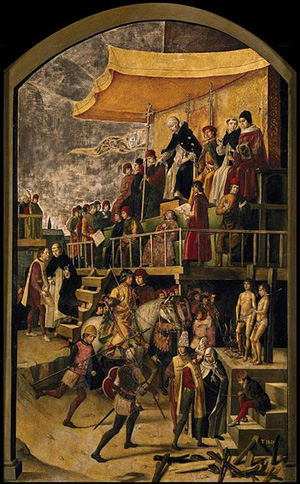
.jpg)

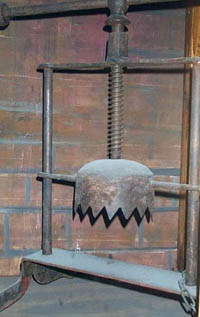
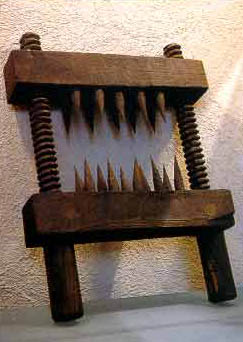
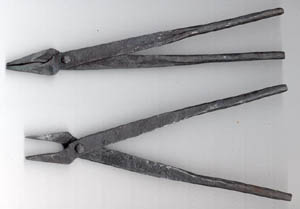
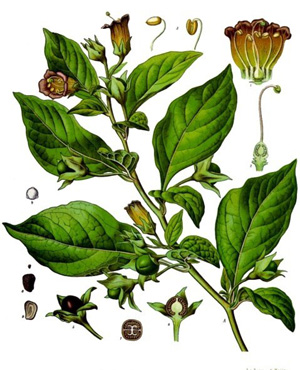



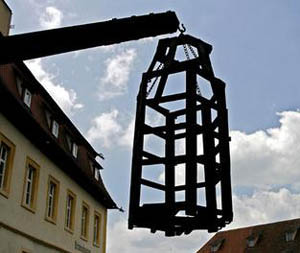
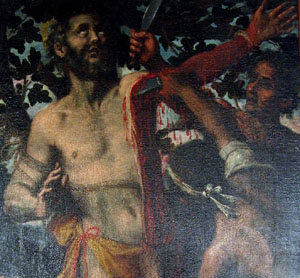
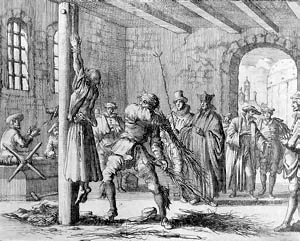
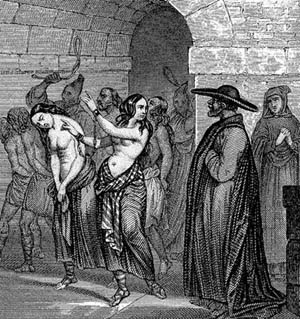
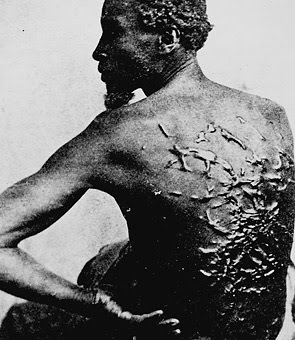
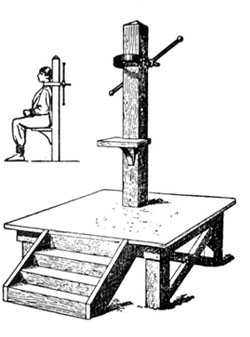 Garrotes
were used in the Middle Ages in Spain and Portugal, and employed
during the conquista of Latin America, as attested by the execution
of the Inca emperor Atahualpa.
Garrotes
were used in the Middle Ages in Spain and Portugal, and employed
during the conquista of Latin America, as attested by the execution
of the Inca emperor Atahualpa. 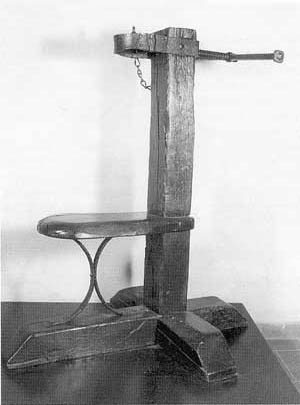
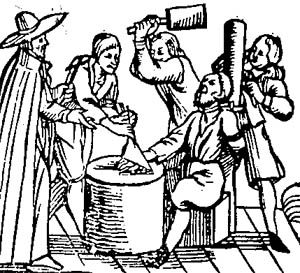
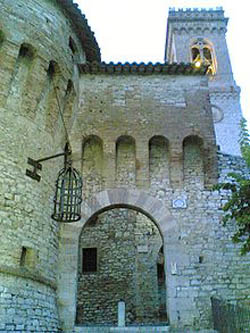
.jpg)
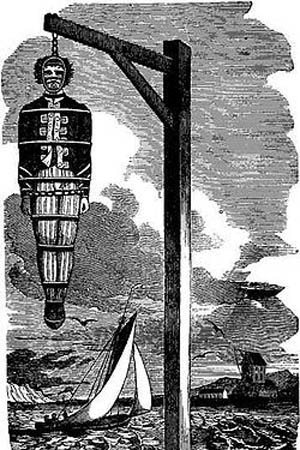
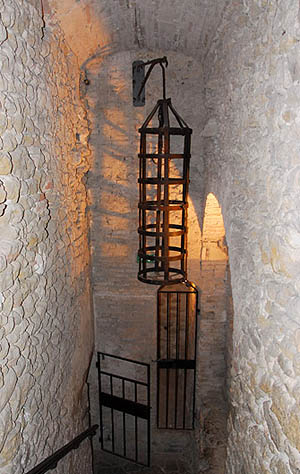
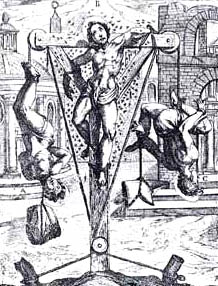
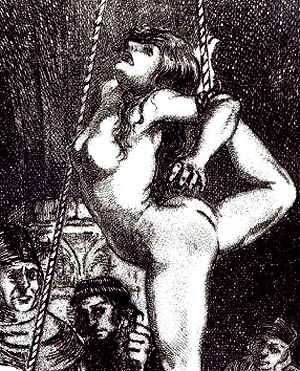
.jpg)
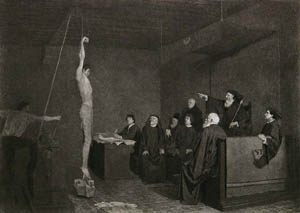
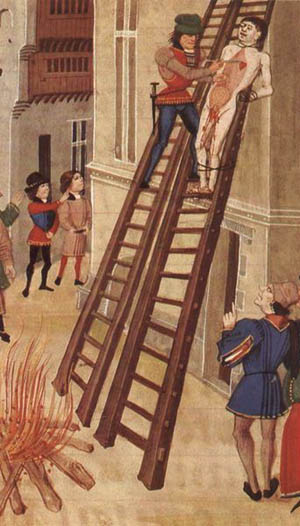
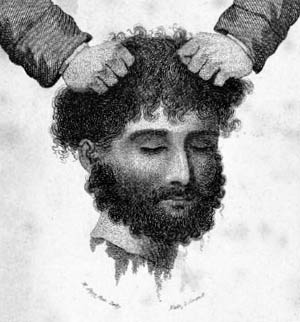

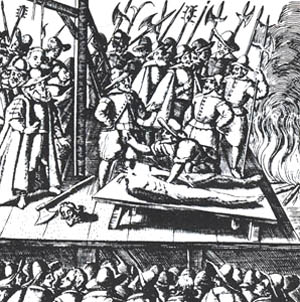
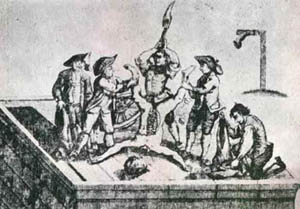
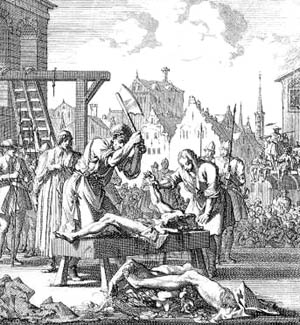
 The
heretic's fork was a torture device, consisting of a length of metal
with two opposed bi-pronged "forks" as well as an attached
belt or strap.
The
heretic's fork was a torture device, consisting of a length of metal
with two opposed bi-pronged "forks" as well as an attached
belt or strap.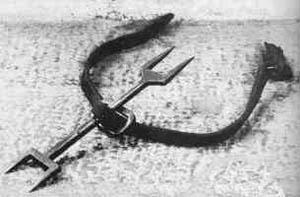
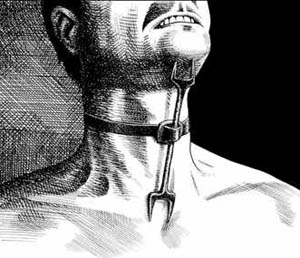
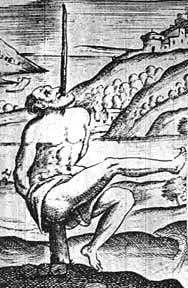
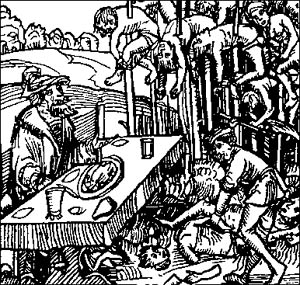
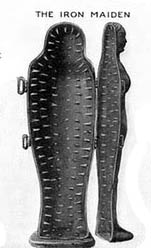 An
iron maiden (German: Eiserne Jungfrau) is a torture device, consisting
of an iron cabinet, with a hinged front, sufficiently tall to enclose
a human being. It usually has a small closable opening so that the
torturer can interrogate the victim and torture or kill a person
by piercing the body with sharp objects (such as knives, spikes
or nails), while he or she is forced to remain standing.
An
iron maiden (German: Eiserne Jungfrau) is a torture device, consisting
of an iron cabinet, with a hinged front, sufficiently tall to enclose
a human being. It usually has a small closable opening so that the
torturer can interrogate the victim and torture or kill a person
by piercing the body with sharp objects (such as knives, spikes
or nails), while he or she is forced to remain standing.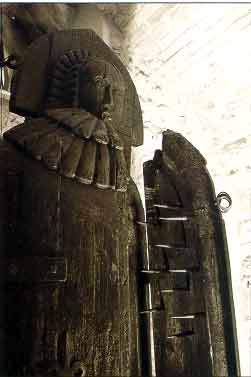
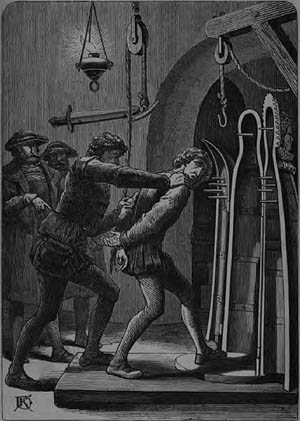
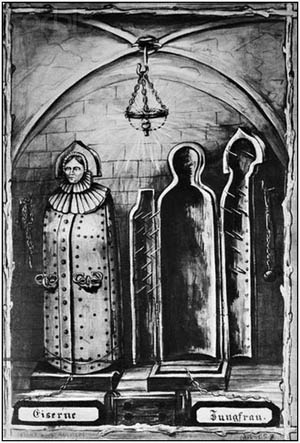
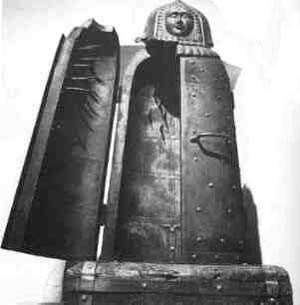
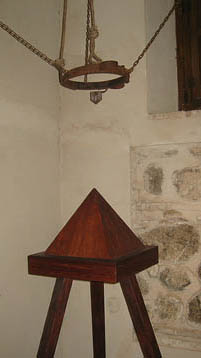
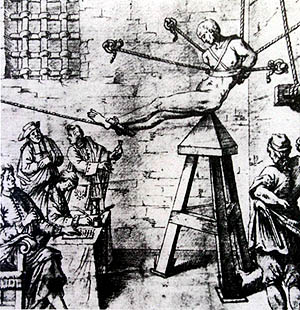
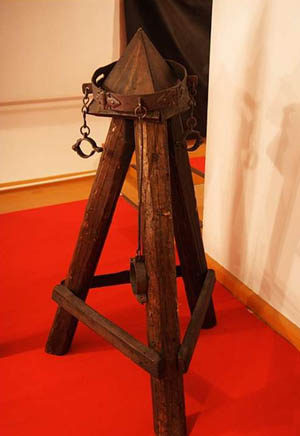
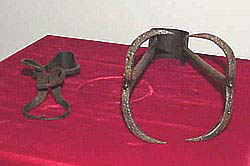
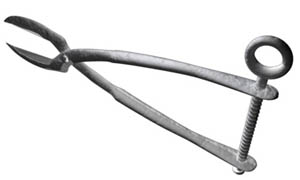
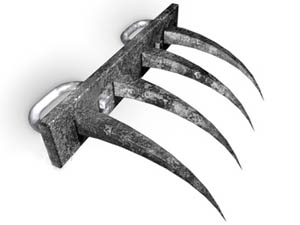
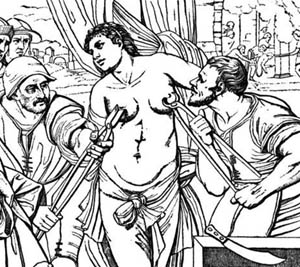
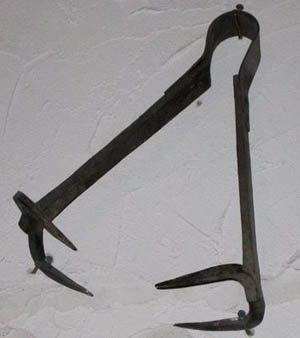


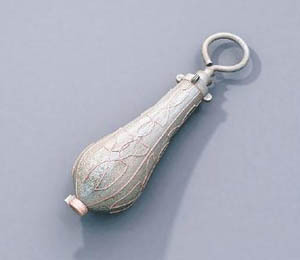
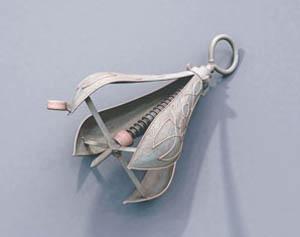
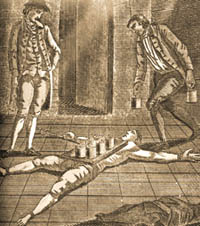
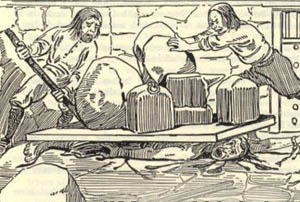
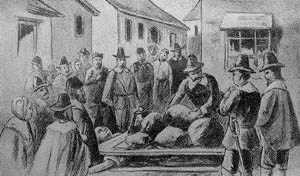
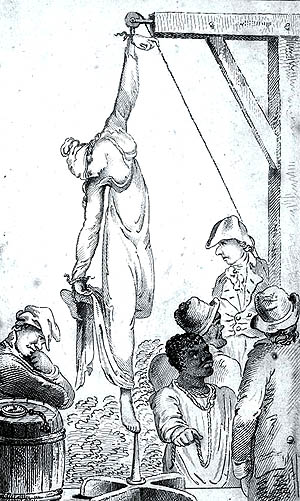
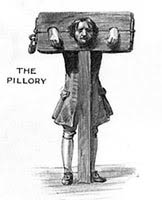 The
pillory was a device made of a wooden or metal framework erected
on a post, with holes for securing the head and hands, formerly
used for punishment by public humiliation and often further physical
abuse, sometimes lethal.
The
pillory was a device made of a wooden or metal framework erected
on a post, with holes for securing the head and hands, formerly
used for punishment by public humiliation and often further physical
abuse, sometimes lethal. 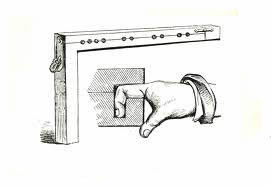
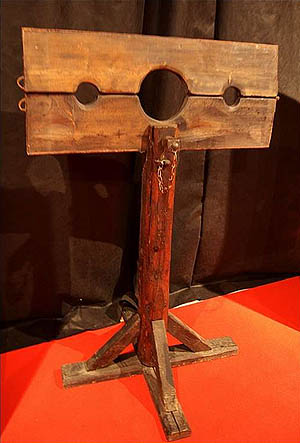
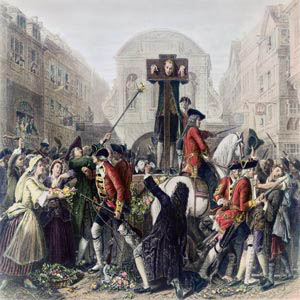
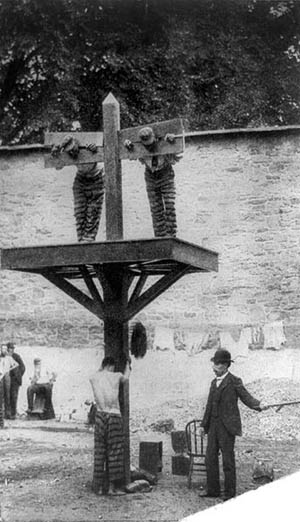
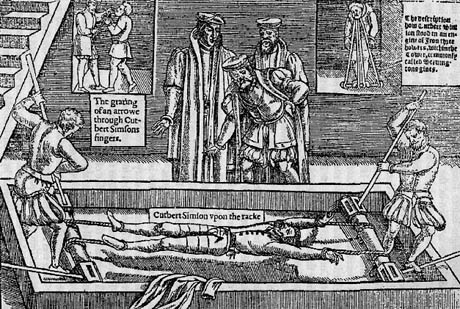
.jpg)
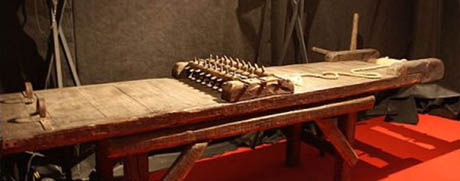
.jpg)
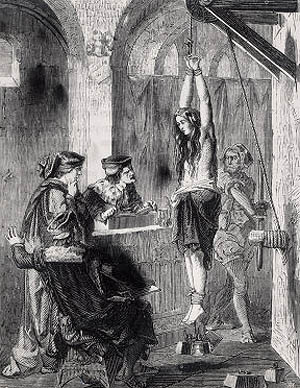
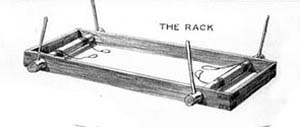
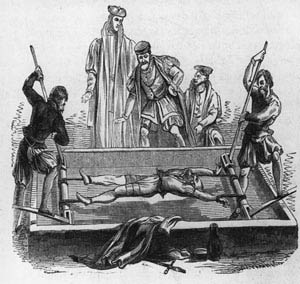
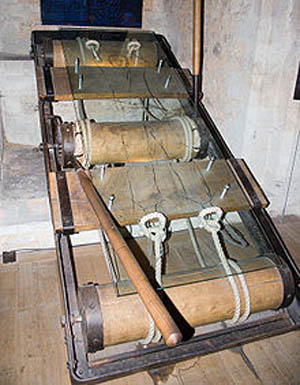
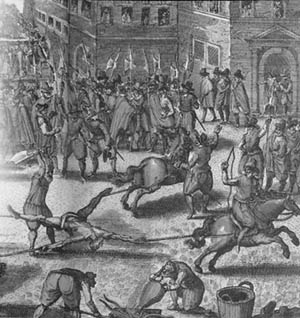

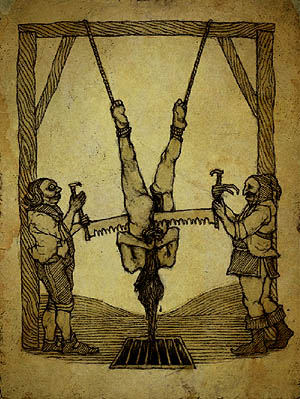
.jpg)
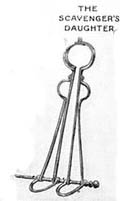 The
Scavenger's Daughter was invented as an instrument of torture in
the reign of Henry VIII by Sir William Skevington (also known as
William Skeffington), Lieutenant of the Tower of London. It was
an A-frame shaped metal rack to which the head was strapped to the
top point of the A, the hands at the mid-point and the legs at the
lower spread ends; swinging the head down and forcing the knees
up in a sitting position.
The
Scavenger's Daughter was invented as an instrument of torture in
the reign of Henry VIII by Sir William Skevington (also known as
William Skeffington), Lieutenant of the Tower of London. It was
an A-frame shaped metal rack to which the head was strapped to the
top point of the A, the hands at the mid-point and the legs at the
lower spread ends; swinging the head down and forcing the knees
up in a sitting position.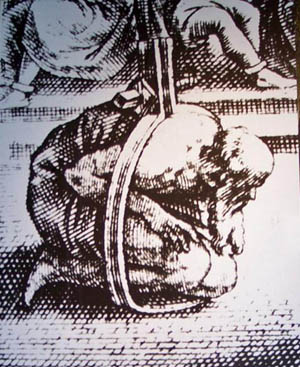
.jpg) Stocks
are devices used in the medieval times as a form of physical punishment
involving public humiliation. The stocks partially immobilised its
victims and they were often exposed in a public place such as the
site of a market to the scorn of those who passed by. Since the
purpose was to punish offenders against the standards of conduct
of the time, anybody could assault, revile or aim filth at the victim.
Stocks
are devices used in the medieval times as a form of physical punishment
involving public humiliation. The stocks partially immobilised its
victims and they were often exposed in a public place such as the
site of a market to the scorn of those who passed by. Since the
purpose was to punish offenders against the standards of conduct
of the time, anybody could assault, revile or aim filth at the victim..jpg)
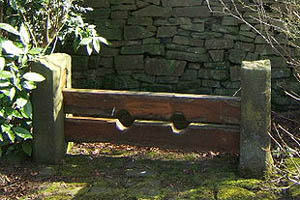
.jpg)
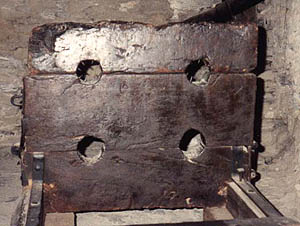
.jpg)
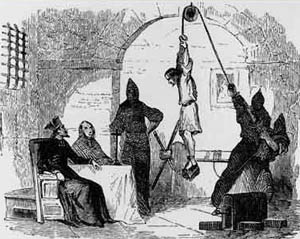
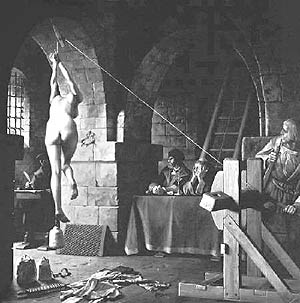
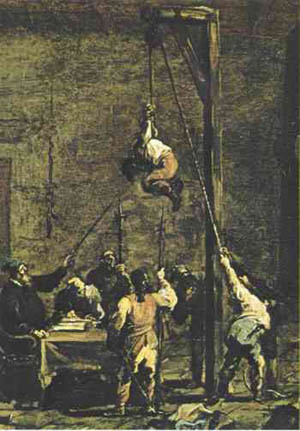


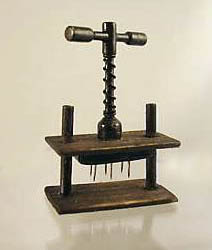
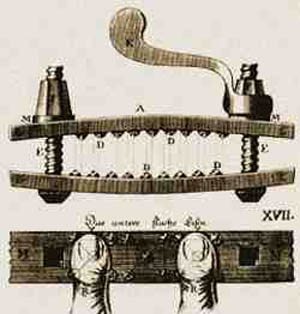
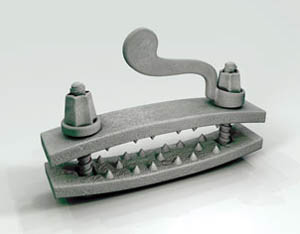
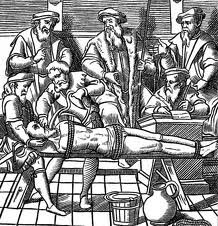
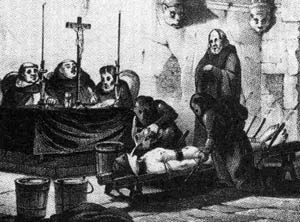
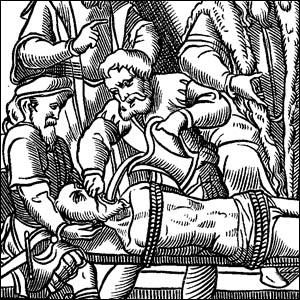

.jpg)
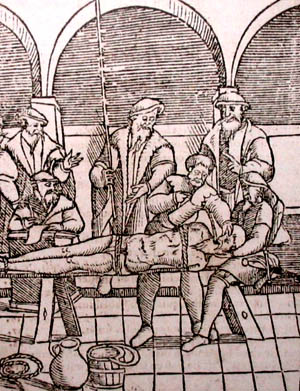
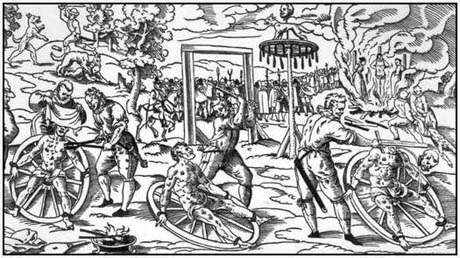
.jpg)

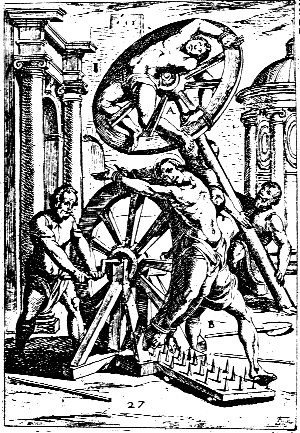
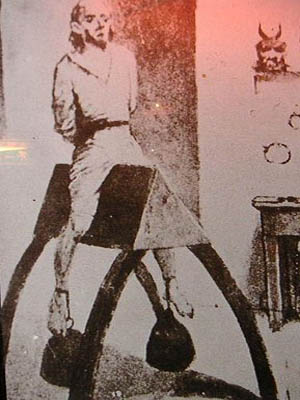
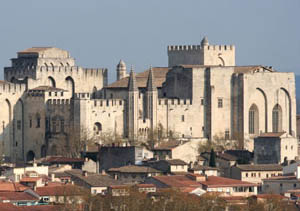
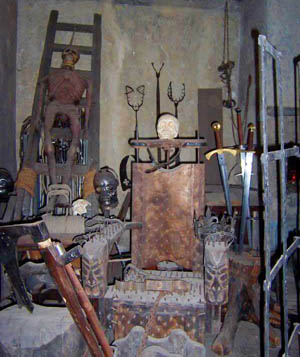
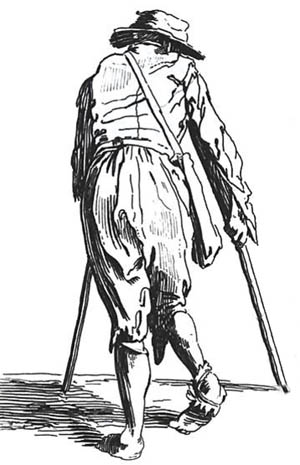
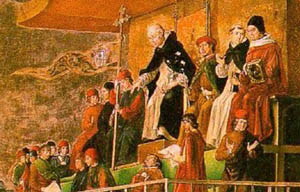
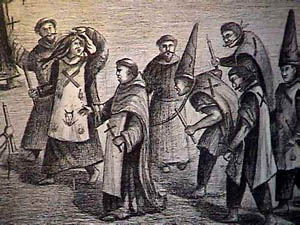
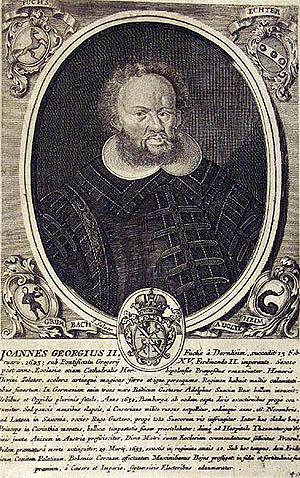
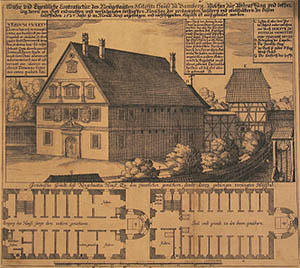
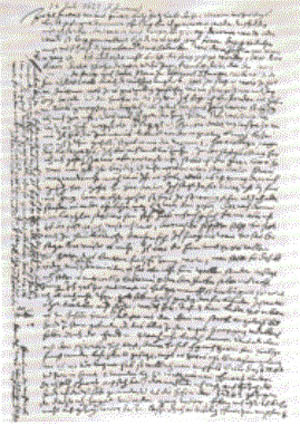
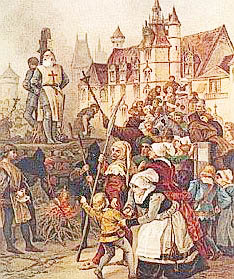
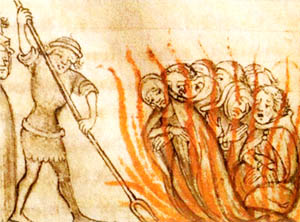
.jpg)